2012年07月29日
Iron Ridge Arms IRA-X THOR 7.62mm
私たちのブログを訪問していただきありがとうございます。あなたがお持ちの場合DIYの要求は私達に電子メールを送信してください。
High-speed, low-drag AR-10-style rifle with repeatable sub-MOA precision!
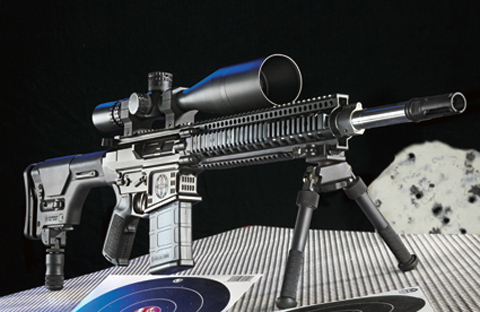
Iron Ridge’s IRA-X family of rifles focuses on getting the important stuff right. The result is a truly exceptional and customizable AR-10-style rifle with all the attention to detail to make it a precision powerhouse. To get the most out of the IRA-X Thor, a Nightforce NXS 5.5-22×56mm scope was mounted.
When it comes to succeeding in a tactical environment, most experts will agree that it ultimately comes down to a matter of doing the basics better. “High-speed, low-drag” doesn’t mean complicated or advanced; it means the ability to perform critical tasks flawlessly under any circumstances—in short, getting the important stuff right. While that wisdom is certainly valid when it comes to tactical skills, it is equally applicable to equipment manufacture. And getting the important stuff right is what Iron Ridge Arms’ IRA-X AR-10-style rifles are all about.
Iron Ridge Arms is a manufacturer and custom shop that specializes in Class II and Class III firearms. Nestled discreetly in an industrial park in Longmont, Colorado, it is owned and operated by veteran gunsmith, machinist and designer Oliver Mazurkiewicz. Through his many years of experience customizing and modifying all brands of tactical rifles and carbines, Mazurkiewicz developed a keen understanding of the critical qualities necessary in that breed. And while many manufacturers do an excellent job of providing these qualities, as a custom gunsmith, Mazurkiewicz always saw room for improvement. He believed that if that extra attention to detail were incorporated into the fundamental construction of the rifle, its “basics” would literally be as good as they could get.
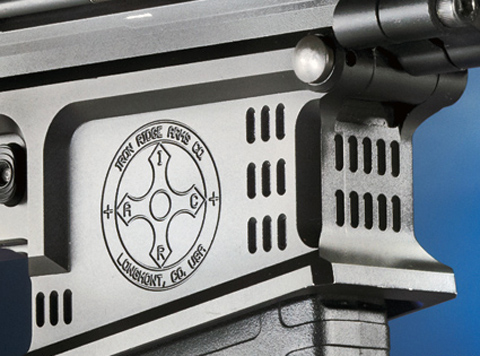
Starting with the right foundation—the IRA-X has meticulously machined upper and lower receivers that are fitted perfectly to withstand the harshest conditions.
The core of the IRA-X is its meticulously machined upper and lower receiver. Designed and engineered to meet Mazurkiewicz’s exacting specifications, these parts are CNC-machined from solid billets of 7075-T6 aluminum in the Iron Ridge shop. Although they are designed to accept components purchased from DPMS, which Mazurkiewicz has carefully selected as “the standard” of quality and consistency for drop-in parts, they are not your run-of-the-mill receivers.
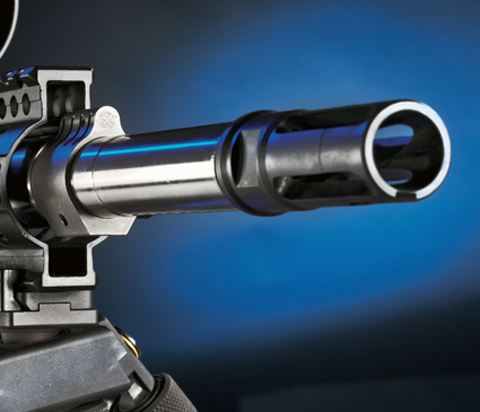
The IRA-X Thor tested for this article featured a custom-machined Rock Creek barrel fitted with a SureFire FH762K03 flash suppressor.
BLOG ARCHIVES

High-speed, low-drag AR-10-style rifle with repeatable sub-MOA precision!

Iron Ridge’s IRA-X family of rifles focuses on getting the important stuff right. The result is a truly exceptional and customizable AR-10-style rifle with all the attention to detail to make it a precision powerhouse. To get the most out of the IRA-X Thor, a Nightforce NXS 5.5-22×56mm scope was mounted.
When it comes to succeeding in a tactical environment, most experts will agree that it ultimately comes down to a matter of doing the basics better. “High-speed, low-drag” doesn’t mean complicated or advanced; it means the ability to perform critical tasks flawlessly under any circumstances—in short, getting the important stuff right. While that wisdom is certainly valid when it comes to tactical skills, it is equally applicable to equipment manufacture. And getting the important stuff right is what Iron Ridge Arms’ IRA-X AR-10-style rifles are all about.
Iron Ridge Arms is a manufacturer and custom shop that specializes in Class II and Class III firearms. Nestled discreetly in an industrial park in Longmont, Colorado, it is owned and operated by veteran gunsmith, machinist and designer Oliver Mazurkiewicz. Through his many years of experience customizing and modifying all brands of tactical rifles and carbines, Mazurkiewicz developed a keen understanding of the critical qualities necessary in that breed. And while many manufacturers do an excellent job of providing these qualities, as a custom gunsmith, Mazurkiewicz always saw room for improvement. He believed that if that extra attention to detail were incorporated into the fundamental construction of the rifle, its “basics” would literally be as good as they could get.

Starting with the right foundation—the IRA-X has meticulously machined upper and lower receivers that are fitted perfectly to withstand the harshest conditions.
The core of the IRA-X is its meticulously machined upper and lower receiver. Designed and engineered to meet Mazurkiewicz’s exacting specifications, these parts are CNC-machined from solid billets of 7075-T6 aluminum in the Iron Ridge shop. Although they are designed to accept components purchased from DPMS, which Mazurkiewicz has carefully selected as “the standard” of quality and consistency for drop-in parts, they are not your run-of-the-mill receivers.

The IRA-X Thor tested for this article featured a custom-machined Rock Creek barrel fitted with a SureFire FH762K03 flash suppressor.
BLOG ARCHIVES

Posted by echigoyaworks
at 21:00
2012年07月29日
Ruger SR-556
私たちのブログを訪問していただきありがとうございます。あなたがお持ちの場合DIYの要求は私達に電子メールを送信してください。
American Fork, UT S.W.A.T. transitions to Ruger’s new SR-556 rifle!
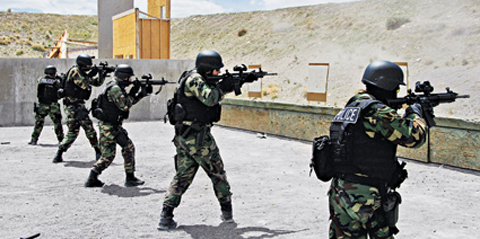
The S.W.A.T. environment is a 360-degree world, and the fast-handling Ruger SR-556 was up to the challenge of being deployed from all angles and distances.
While it is certainly true that smaller departments do not face all of the problems a big agency experiences, the idea that “all cops are the same” and “policing is the same everywhere” strikes me mostly as political rhetoric. Parts of the day-to-day job may be similar, but working as a police officer in a 15-man department is not the “same” as a 35,000 man department. Each faces their own set of challenges, some similar, many completely different.
One of the challenges faced by many smaller police departments, is dealing with big-city crime with small-city assets. Two of the areas where this has very significant impact are training and tactical deployments. Large departments often have training divisions as contrasted to a smaller agency that likely does not even have training officers. That is something an officer does in conjunction with the rest of their duties. The same is true for S.W.A.T. teams. Watching the various television shows you would think everyone has a dedicated S.W.A.T. team with vans, ‘copters and tanks. That is simply not true. Most do their job and train for it when they are not “on duty.”

The Ruger is well equipped from the factory. Simply add a sling and optic of your choice and you are ready for the next callout.
BLOG ARCHIVES

American Fork, UT S.W.A.T. transitions to Ruger’s new SR-556 rifle!

The S.W.A.T. environment is a 360-degree world, and the fast-handling Ruger SR-556 was up to the challenge of being deployed from all angles and distances.
While it is certainly true that smaller departments do not face all of the problems a big agency experiences, the idea that “all cops are the same” and “policing is the same everywhere” strikes me mostly as political rhetoric. Parts of the day-to-day job may be similar, but working as a police officer in a 15-man department is not the “same” as a 35,000 man department. Each faces their own set of challenges, some similar, many completely different.
One of the challenges faced by many smaller police departments, is dealing with big-city crime with small-city assets. Two of the areas where this has very significant impact are training and tactical deployments. Large departments often have training divisions as contrasted to a smaller agency that likely does not even have training officers. That is something an officer does in conjunction with the rest of their duties. The same is true for S.W.A.T. teams. Watching the various television shows you would think everyone has a dedicated S.W.A.T. team with vans, ‘copters and tanks. That is simply not true. Most do their job and train for it when they are not “on duty.”

The Ruger is well equipped from the factory. Simply add a sling and optic of your choice and you are ready for the next callout.
BLOG ARCHIVES

Posted by echigoyaworks
at 16:00
2012年07月29日
Sig Sauer 1911 Scorpion
私たちのブログを訪問していただきありがとうございます。あなたがお持ちの場合DIYの要求は私達に電子メールを送信してください。
Sig Sauer has a reputation for making high quality and innovative firearms. A few weeks ago we took a look at the S&W 329PD as a backup handgun when carrying afield. Given that 2011 is the centennial of Jonathan Browning's excellent 1911 pistol; we decided to take a look at Sig Sauer's new 1911 Scorpion. While the 1911 in 45ACP doesn't pack the punch of some revolver only cartridges, its durability and reliability has made it a favorite of hunters for generations.
The Sig Sauer 1911 Scorpion.

Sig is not new to manufacturing 1911's, having produced many models under the GSR label for years. They also produced the Sig 220 in a variety of cartridges (although 45ACP is the only production cartridge today) for decades. The 220 in a SA/DA configuration is definitely different than a 1911, but the slim profile and similar ergonomics to the 1911 make it a good choice when considering a single stack, all metal, 45ACP pistol.
The most noticeable features of the new 1911 Scorpion is the new Hogue G10 grips and the desert tan Cerakote finish. The grips, with what Hogue calls "Piranha" texturing, really grabs the hands. Combine the grip with the high lines-per-inch front strap checking and the Scorpion does not lack in hand grip, which makes the gun easier to control under slick wet conditions. In addition the grip also has an integrated back strap and beveled out magazine well extension that make it easier to guide in a loaded magazine when reloading.

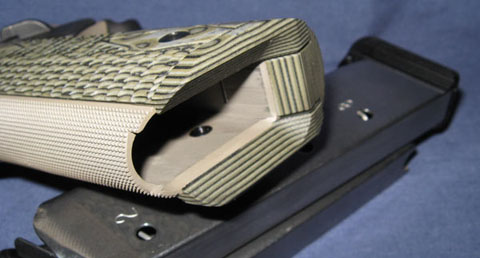
The Hogue G10 Piranha grip is colorful and adds a good deal of texture. A nice addition in the back strap has been changed out for the matching texturing as well.
The grip and back strap come together to form an extended magazine well that helps guide in a quick magazine reload.
The other noticeable feature is the factory Cerakote finish that has been applied over the stainless steel frame and slide. Cerakote is a ceramic based finish that armors the firearm and improves abrasion and corrosion resistance. This makes the Scorpion much more resistant to scratches and rust. While we did not test the coating for scratch resistance, past experience with other firearms coated with Cerakote or Duracoat have proven to be effective in fighting scratches and rust. Although you should always still take the time to clean off your guns after use and/or after getting wet.

Two piece feed ramp. Notice also that the Cerakote finish is on the inside of the slide as well as the frame.
Beyond the grips and finish, Sig has included a variety of other features that have come to be expected of a higher end 1911. Namely low profile tritium night sights, a lightweight trigger, a larger external extractor, beaver-tail safety grip, and an ambidextrous safety. The ambidextrous safety uses the "short" format which is nice if you intend to equip the Scorpion with a Crimson Trace laser grip. Longer, standard ambidextrous safeties tend to hit the laser housing and do not work correctly. The Scorpion is also equipped with a picatinny front rail for attaching lights or lasers at your discretion. Sig also includes two eight round magazines with the Scorpion.

The "short" ambidextrous safety. The Scorpion also includes low profile Trijicon night sights.
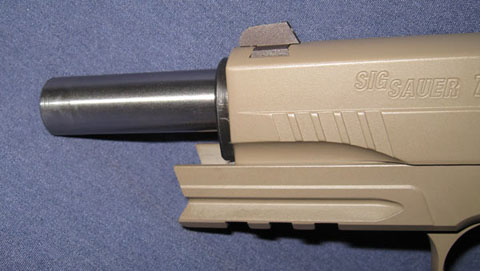
The Scorpion does not have a full length guide rod, but it does include a picatinny rail.
The Scorpion, like most Sig 1911's, is exceptionally tight out of the box. There is little wobble in the slide and will take a few hundred rounds to break in. The trigger breaks cleanly and crisply with no noticeable burrs.
On the downsides the Scorpion does not have a full length guide rod, no front slide serrations, and the barrel ramp is a standard two piece design. We are also not particularly fond of the flat triggers; however this is personal preference and being a 1911 the trigger can be changed.
Overall the Scorpion is an excellent offering considering the asking price. It should be long lasting and corrosion/scratch resistant and offers an excellent grip. The 1911 makes an excellent back up firearm when in the backcountry and the Scorpion is worth considering if you're in the market for a new sidearm.
NEWS ARCHIVES

Sig Sauer has a reputation for making high quality and innovative firearms. A few weeks ago we took a look at the S&W 329PD as a backup handgun when carrying afield. Given that 2011 is the centennial of Jonathan Browning's excellent 1911 pistol; we decided to take a look at Sig Sauer's new 1911 Scorpion. While the 1911 in 45ACP doesn't pack the punch of some revolver only cartridges, its durability and reliability has made it a favorite of hunters for generations.
The Sig Sauer 1911 Scorpion.

Sig is not new to manufacturing 1911's, having produced many models under the GSR label for years. They also produced the Sig 220 in a variety of cartridges (although 45ACP is the only production cartridge today) for decades. The 220 in a SA/DA configuration is definitely different than a 1911, but the slim profile and similar ergonomics to the 1911 make it a good choice when considering a single stack, all metal, 45ACP pistol.
The most noticeable features of the new 1911 Scorpion is the new Hogue G10 grips and the desert tan Cerakote finish. The grips, with what Hogue calls "Piranha" texturing, really grabs the hands. Combine the grip with the high lines-per-inch front strap checking and the Scorpion does not lack in hand grip, which makes the gun easier to control under slick wet conditions. In addition the grip also has an integrated back strap and beveled out magazine well extension that make it easier to guide in a loaded magazine when reloading.


The Hogue G10 Piranha grip is colorful and adds a good deal of texture. A nice addition in the back strap has been changed out for the matching texturing as well.
The grip and back strap come together to form an extended magazine well that helps guide in a quick magazine reload.
The other noticeable feature is the factory Cerakote finish that has been applied over the stainless steel frame and slide. Cerakote is a ceramic based finish that armors the firearm and improves abrasion and corrosion resistance. This makes the Scorpion much more resistant to scratches and rust. While we did not test the coating for scratch resistance, past experience with other firearms coated with Cerakote or Duracoat have proven to be effective in fighting scratches and rust. Although you should always still take the time to clean off your guns after use and/or after getting wet.

Two piece feed ramp. Notice also that the Cerakote finish is on the inside of the slide as well as the frame.
Beyond the grips and finish, Sig has included a variety of other features that have come to be expected of a higher end 1911. Namely low profile tritium night sights, a lightweight trigger, a larger external extractor, beaver-tail safety grip, and an ambidextrous safety. The ambidextrous safety uses the "short" format which is nice if you intend to equip the Scorpion with a Crimson Trace laser grip. Longer, standard ambidextrous safeties tend to hit the laser housing and do not work correctly. The Scorpion is also equipped with a picatinny front rail for attaching lights or lasers at your discretion. Sig also includes two eight round magazines with the Scorpion.

The "short" ambidextrous safety. The Scorpion also includes low profile Trijicon night sights.

The Scorpion does not have a full length guide rod, but it does include a picatinny rail.
The Scorpion, like most Sig 1911's, is exceptionally tight out of the box. There is little wobble in the slide and will take a few hundred rounds to break in. The trigger breaks cleanly and crisply with no noticeable burrs.
On the downsides the Scorpion does not have a full length guide rod, no front slide serrations, and the barrel ramp is a standard two piece design. We are also not particularly fond of the flat triggers; however this is personal preference and being a 1911 the trigger can be changed.
Overall the Scorpion is an excellent offering considering the asking price. It should be long lasting and corrosion/scratch resistant and offers an excellent grip. The 1911 makes an excellent back up firearm when in the backcountry and the Scorpion is worth considering if you're in the market for a new sidearm.
NEWS ARCHIVES

Posted by echigoyaworks
at 10:00
2012年07月28日
Wilson Combat X-Tac .45 ACP
私たちのブログを訪問していただきありがとうございます。あなたがお持ちの場合DIYの要求は私達に電子メールを送信してください。
Custom-quality 1911 at a duty-ready price point!
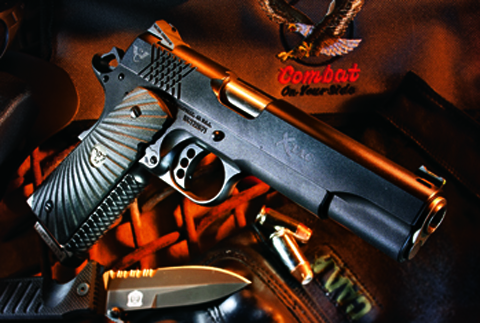
The X-TAC from Wilson Combat is a simple and straightforward custom 1911, featuring highly effective “X” pattern serrations adorning the slide and the grip frame of the pistol.
THE 1911 PISTOL has experienced a pretty significant resurgence in the last few years. A pistol that was once maligned as “too aggressive” or “unsafe” by police administrators is once again gaining wider acceptance. With the exception of a few states, and some less knowledgeable administrators and armorers this mythology has all but disappeared. Agencies are not only allowing the 1911 pistol as a personal choice, many are moving to them department wide. It is a testament to the design for sure. The 1911 pistol is rugged, reliable, accurate and has proven itself in actual gunfights time and time again. Tactical teams and high-risk units have used them for years with great success. Given the opportunity, many special operations units will take a 1911 over just about any other pistol. It is a proven design, and as is often the case, it is making a full circle back into popularity.
There is a reason this particular design has withstood the times — it aims and shoots naturally for most people almost without regard to experience level. Given various grip changes it can accommodate most any hand, and the slim design makes it perfect for inside the waistband carry. Given the quality of materials and machining today they can be built to incredible tolerances. Even some custom pistols today cost less than the same upgrades would have cost 15 years ago. It has really put the 1911 in a place where it can accommodate just about any task it is called upon to undertake.
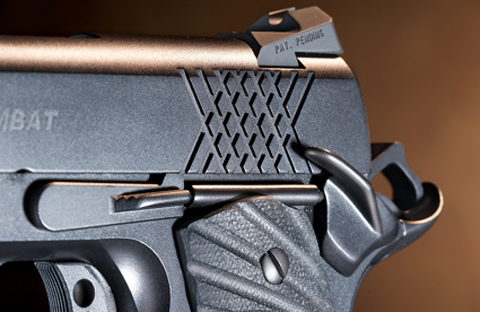
The X-TAC features a non-ambidextrous thumb safety as well a generously upswept beavertail grip safety to help prevent “hammer bite.”
During the initial onslaught of the polymer pistol, the 1911 enjoyed broad use in the police world, especially undercover, off-duty, or in plainclothes. This was especially true for agencies that issued 5-shot .38 Special revolvers to their detectives. Many wanted the extra capacity and the ability to use the venerable .45 ACP cartridge. This was especially true for those officers that found themselves in need of their pistol as something other than a desk ornament.
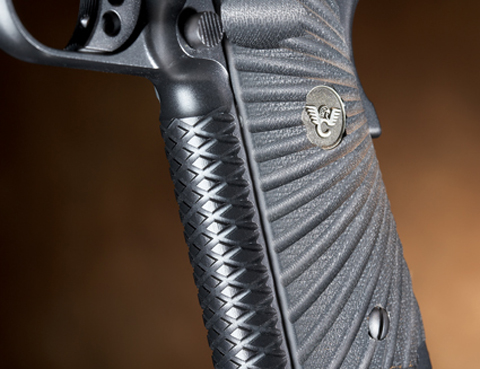
Key to the X-TAC’s excellent handling characteristics is the “X” pattern serrations on the front- and backstraps. The X-TAC features Wilson Combat’s iconic “Starburst” grips, featuring smooth grooves radiating out from the center.
BLOG ARCHIVES

Custom-quality 1911 at a duty-ready price point!

The X-TAC from Wilson Combat is a simple and straightforward custom 1911, featuring highly effective “X” pattern serrations adorning the slide and the grip frame of the pistol.
THE 1911 PISTOL has experienced a pretty significant resurgence in the last few years. A pistol that was once maligned as “too aggressive” or “unsafe” by police administrators is once again gaining wider acceptance. With the exception of a few states, and some less knowledgeable administrators and armorers this mythology has all but disappeared. Agencies are not only allowing the 1911 pistol as a personal choice, many are moving to them department wide. It is a testament to the design for sure. The 1911 pistol is rugged, reliable, accurate and has proven itself in actual gunfights time and time again. Tactical teams and high-risk units have used them for years with great success. Given the opportunity, many special operations units will take a 1911 over just about any other pistol. It is a proven design, and as is often the case, it is making a full circle back into popularity.
There is a reason this particular design has withstood the times — it aims and shoots naturally for most people almost without regard to experience level. Given various grip changes it can accommodate most any hand, and the slim design makes it perfect for inside the waistband carry. Given the quality of materials and machining today they can be built to incredible tolerances. Even some custom pistols today cost less than the same upgrades would have cost 15 years ago. It has really put the 1911 in a place where it can accommodate just about any task it is called upon to undertake.

The X-TAC features a non-ambidextrous thumb safety as well a generously upswept beavertail grip safety to help prevent “hammer bite.”
During the initial onslaught of the polymer pistol, the 1911 enjoyed broad use in the police world, especially undercover, off-duty, or in plainclothes. This was especially true for agencies that issued 5-shot .38 Special revolvers to their detectives. Many wanted the extra capacity and the ability to use the venerable .45 ACP cartridge. This was especially true for those officers that found themselves in need of their pistol as something other than a desk ornament.

Key to the X-TAC’s excellent handling characteristics is the “X” pattern serrations on the front- and backstraps. The X-TAC features Wilson Combat’s iconic “Starburst” grips, featuring smooth grooves radiating out from the center.
BLOG ARCHIVES

Posted by echigoyaworks
at 21:00
2012年07月28日
SBR 5.56 Uppers
私たちのブログを訪問していただきありがとうございます。あなたがお持ちの場合DIYの要求は私達に電子メールを送信してください。
Seven short-barrel rifle uppers to fit an array of mission requirements!

SBRs (Short-Barreled Rifles) offer a lot of practicality in a small package, for a price that is significantly less than the select-fire rifle or sub gun. Manufacturers such as CMMG, LaRue Tactical, LWRC International, Stag Arms, Troy Industries, Wilson Combat and Noveske Rifle Works (above represent a wide range of products and price points to meet the specific needs of the end-user.

The 12″ LaRue Stealth can serve in both a CQB and precision rifle role. It is shown here equipped with a Magpul PRS stock, Leupold MK 4 scope with LaRue mount, and SureFire’s new Mini suppressor.

The CMMG 7″ upper is among the shortest of the short-barrels, shown here with an Aimpoint Comp M4S, S&W/Troy Back-up Iron Sights and a Magpul Angled Foregrip.

The 8″ LWRC PSD is a piston rifle that is designed for CQB and protective missions. It is equipped with Magpul MOE stock and grip, an Aimpoint T-1 Micro with a LaRue mount and LWRC iron sights shown in the raised position.

The Noveske Rifeworks upper is based on a VLTOR upper receiver and features a 10.5″ polygonal-rifled barrel, Noveske rail, and the Switchblock. It is also shown with the Aimpoint T-1 and SureFire Mini suppressor.

Troy Industries offers the M7 conversion as a kit. Note the Troy vertical grip, pistol grip and sights. The Aimpoint T-1 is mounted on the shorter LaRue mount for an absolute co-index. The complete rifle can be broken down and transported in the factory-provided Hardigg case.
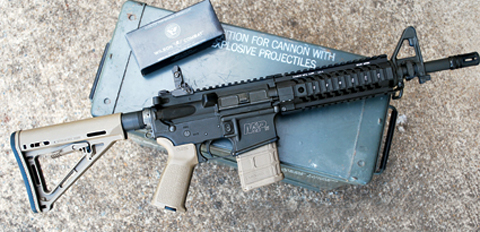
Stag Arms can provide their rifles and uppers in both right- and left-hand versions. The 11.5″ upper features a Samson rail, standard front sight, Arms 71L-R rear sight, and an A2 flash suppressor.
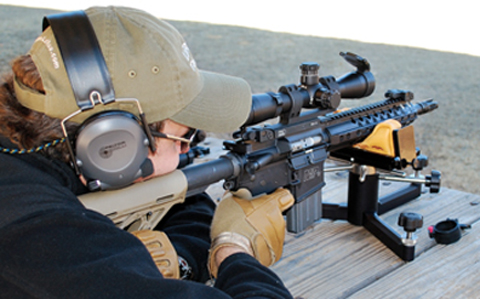
The Wilson Combat upper features a match-grade barrel and their new TRIM rail. It is a slim-line rail that allows the user to mount short Picatinny rail sections in the desired location.
BLOG ARCHIVES

Seven short-barrel rifle uppers to fit an array of mission requirements!

SBRs (Short-Barreled Rifles) offer a lot of practicality in a small package, for a price that is significantly less than the select-fire rifle or sub gun. Manufacturers such as CMMG, LaRue Tactical, LWRC International, Stag Arms, Troy Industries, Wilson Combat and Noveske Rifle Works (above represent a wide range of products and price points to meet the specific needs of the end-user.

The 12″ LaRue Stealth can serve in both a CQB and precision rifle role. It is shown here equipped with a Magpul PRS stock, Leupold MK 4 scope with LaRue mount, and SureFire’s new Mini suppressor.

The CMMG 7″ upper is among the shortest of the short-barrels, shown here with an Aimpoint Comp M4S, S&W/Troy Back-up Iron Sights and a Magpul Angled Foregrip.

The 8″ LWRC PSD is a piston rifle that is designed for CQB and protective missions. It is equipped with Magpul MOE stock and grip, an Aimpoint T-1 Micro with a LaRue mount and LWRC iron sights shown in the raised position.

The Noveske Rifeworks upper is based on a VLTOR upper receiver and features a 10.5″ polygonal-rifled barrel, Noveske rail, and the Switchblock. It is also shown with the Aimpoint T-1 and SureFire Mini suppressor.

Troy Industries offers the M7 conversion as a kit. Note the Troy vertical grip, pistol grip and sights. The Aimpoint T-1 is mounted on the shorter LaRue mount for an absolute co-index. The complete rifle can be broken down and transported in the factory-provided Hardigg case.

Stag Arms can provide their rifles and uppers in both right- and left-hand versions. The 11.5″ upper features a Samson rail, standard front sight, Arms 71L-R rear sight, and an A2 flash suppressor.

The Wilson Combat upper features a match-grade barrel and their new TRIM rail. It is a slim-line rail that allows the user to mount short Picatinny rail sections in the desired location.
BLOG ARCHIVES

Posted by echigoyaworks
at 16:00
2012年07月28日
Ruger 10/22
私たちのブログを訪問していただきありがとうございます。あなたがお持ちの場合DIYの要求は私達に電子メールを送信してください。
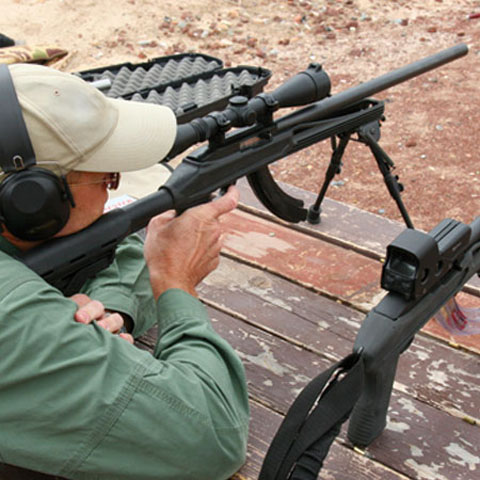
The Ruger 10/22 is the premier semi-automatic, rimfire rifle in the world today. Introduced almost 50 years ago, Ruger has sold millions of the ultra-reliable 10/22 rifles since 1964.
The 10/22 fires the affordable .22 LR cartridge, meaning a shooter can spend hours of great fun at the range without breaking the bank. Ruger’s rotary magazine is extremely reliable, and a 10 round magazine is standard with all new guns. Ruger also makes a five round magazine, and introduced a factory 25 round magazine in May of 2011.

In addition to its rugged reliability, firearm enthusiasts love the 10/22 for its versatility. Ruger makes the rifle in a variety of configurations with synthetic and wood stocks, varying barrel lengths and finishes. In years past, Ruger chambered the 10/22 in both the .22 WMR and .17 HMR cartridges.
The Ruger 10/22 rifle exhibits great handling characteristics, and unlike many .22 LR rifles, it is designed for an adult. This means the gun has excellent fit characteristics for many people. Prior to 1964, many .22 LR rifles were smaller, youth-type guns.
The receiver is precision machined from aluminum alloy, though the now discontinued .22 WMR model used a steel receiver. The 10/22 is a straight blowback design, which has proved to be exceptionally reliable in this rifle.
Airsoft version of the Ruger 10/22 is the KJworks Hawkeye
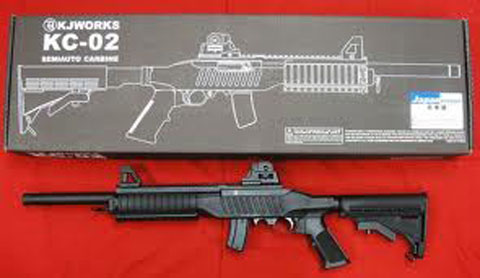
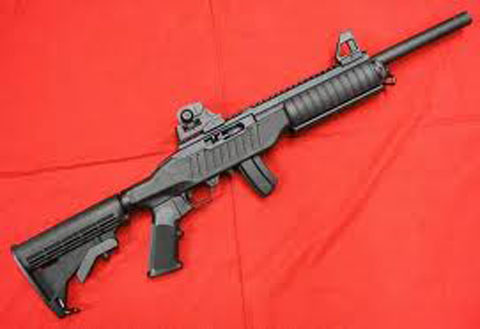
BLOG ARCHIVES


The Ruger 10/22 is the premier semi-automatic, rimfire rifle in the world today. Introduced almost 50 years ago, Ruger has sold millions of the ultra-reliable 10/22 rifles since 1964.
The 10/22 fires the affordable .22 LR cartridge, meaning a shooter can spend hours of great fun at the range without breaking the bank. Ruger’s rotary magazine is extremely reliable, and a 10 round magazine is standard with all new guns. Ruger also makes a five round magazine, and introduced a factory 25 round magazine in May of 2011.

In addition to its rugged reliability, firearm enthusiasts love the 10/22 for its versatility. Ruger makes the rifle in a variety of configurations with synthetic and wood stocks, varying barrel lengths and finishes. In years past, Ruger chambered the 10/22 in both the .22 WMR and .17 HMR cartridges.
The Ruger 10/22 rifle exhibits great handling characteristics, and unlike many .22 LR rifles, it is designed for an adult. This means the gun has excellent fit characteristics for many people. Prior to 1964, many .22 LR rifles were smaller, youth-type guns.
The receiver is precision machined from aluminum alloy, though the now discontinued .22 WMR model used a steel receiver. The 10/22 is a straight blowback design, which has proved to be exceptionally reliable in this rifle.
Airsoft version of the Ruger 10/22 is the KJworks Hawkeye


BLOG ARCHIVES

Posted by echigoyaworks
at 10:00
2012年07月27日
.308 Perseus Precision
私たちのブログを訪問していただきありがとうございます。あなたがお持ちの場合DIYの要求は私達に電子メールを送信してください。
Underground Skunkworks’ rugged, surgical sniper with a 3/8-MOA guarantee!
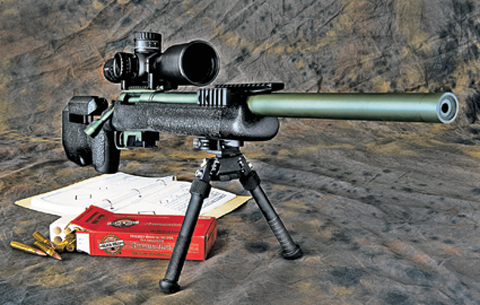
Hand finished from muzzle to receiver, the Perseus features an 11-degree recessed crown. Its threads are cut to within .0001-inch or less. With its adjustable Manners MCS-T4A stock, the precise and solidly built Perseus provides the shooter with an instantly stable and consistent firing platform.
In an age where new offerings come with equal parts marketing pitch and reductive disclaimers, it is a bit of a shock, at first, to encounter a rifle that not only shoots to its manufacturer’s claims, but exceeds them. The Columbia Falls, Montana, rifle company Underground Skunkworks, or UGSW for short, has produced what might be the finest production precision rifle on the market today—the Perseus. Designed for law enforcement missions requiring surgical engagements of targets, the Perseus is a rugged and reliable tool with razor-thin accuracy.
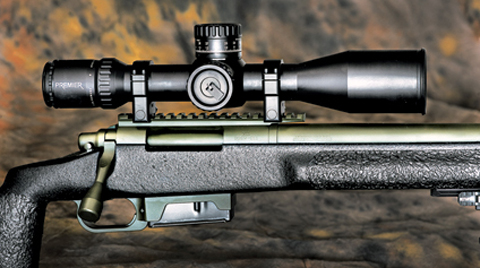
Sporting a custom-designed, Timney-made trigger, the Perseus’ 911 action can accept AW or AICS magazines and be topped off via the breech.
From his humble beginnings as an engineer, UGSW President and Founder Mike Bush has applied an obsessive attention to detail and practical design techniques to correct the flaws and enhance the strengths of the modern-era bolt-action precision rifle. Raised at his father’s elbow, who was a law enforcement officer, in their Mobile, Alabama, diesel shop, Bush went on to earn a degree in electronics engineering. With both a formal and practical education in engineering and design, Bush fostered a lifelong interest in perfecting mechanical precision and long-range shooting. Watching firsthand as FBI HRT shooters tested, broke, fixed and improved upon existing production rifles, Bush learned a crucial lesson in rifle design: “I was disappointed in what I saw as an across-the-board inconsistency in the tolerances of production rifles. Twist rates, fit and finish varied considerably within a single model produced in the same production run from the same factory.”
For the Perseus, Bush set out to design a duty rifle that modernized the M24/M40 platform, keeping what worked and eliminating what did not. “The core capability of this system had to provide both cold-bore and sustained-fire accuracy. There is little on the rifle that is not available somewhere on the open market, but the key is how the highest quality components are harmonized and fit.”
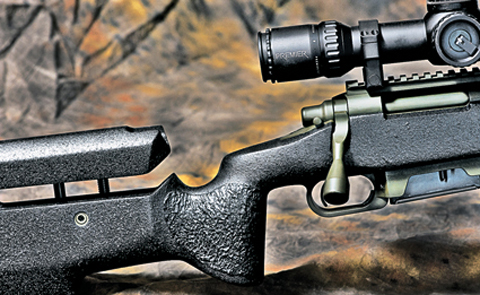
The Perseus features oversized bolt knobs and an Oberndorf-style mag release for fast handling in wet conditions or with gloved hands.
BLOG ARCHIVES

Underground Skunkworks’ rugged, surgical sniper with a 3/8-MOA guarantee!

Hand finished from muzzle to receiver, the Perseus features an 11-degree recessed crown. Its threads are cut to within .0001-inch or less. With its adjustable Manners MCS-T4A stock, the precise and solidly built Perseus provides the shooter with an instantly stable and consistent firing platform.
In an age where new offerings come with equal parts marketing pitch and reductive disclaimers, it is a bit of a shock, at first, to encounter a rifle that not only shoots to its manufacturer’s claims, but exceeds them. The Columbia Falls, Montana, rifle company Underground Skunkworks, or UGSW for short, has produced what might be the finest production precision rifle on the market today—the Perseus. Designed for law enforcement missions requiring surgical engagements of targets, the Perseus is a rugged and reliable tool with razor-thin accuracy.

Sporting a custom-designed, Timney-made trigger, the Perseus’ 911 action can accept AW or AICS magazines and be topped off via the breech.
From his humble beginnings as an engineer, UGSW President and Founder Mike Bush has applied an obsessive attention to detail and practical design techniques to correct the flaws and enhance the strengths of the modern-era bolt-action precision rifle. Raised at his father’s elbow, who was a law enforcement officer, in their Mobile, Alabama, diesel shop, Bush went on to earn a degree in electronics engineering. With both a formal and practical education in engineering and design, Bush fostered a lifelong interest in perfecting mechanical precision and long-range shooting. Watching firsthand as FBI HRT shooters tested, broke, fixed and improved upon existing production rifles, Bush learned a crucial lesson in rifle design: “I was disappointed in what I saw as an across-the-board inconsistency in the tolerances of production rifles. Twist rates, fit and finish varied considerably within a single model produced in the same production run from the same factory.”
For the Perseus, Bush set out to design a duty rifle that modernized the M24/M40 platform, keeping what worked and eliminating what did not. “The core capability of this system had to provide both cold-bore and sustained-fire accuracy. There is little on the rifle that is not available somewhere on the open market, but the key is how the highest quality components are harmonized and fit.”

The Perseus features oversized bolt knobs and an Oberndorf-style mag release for fast handling in wet conditions or with gloved hands.
BLOG ARCHIVES

Posted by echigoyaworks
at 21:00
2012年07月27日
Blackwater Pistol
私たちのブログを訪問していただきありがとうございます。あなたがお持ちの場合DIYの要求は私達に電子メールを送信してください。

Blackwater sure are pushing their brand. I am sure they will have Blackwater action-figures ready for Christmas.
The SIG SAUER® P226 Blackwater Special Edition was designed in cooperation with some of the world’s best known experts in tactical operations – Blackwater Training Center. When personal protection of world leaders in high-risk environments is your job then you only want the best equipment. You want a SIG SAUER® pistol because it’s engineered to perform and built to protect.
The Blackwater Special Edition P226 is a full-sized 9mm featuring a stainless steel slide with rugged, wear-resistant Nitron® finish, front cocking serrations and SIGLITE® contrasting red front and green rear night sights. The frame is black hard anodized light weight alloy with integral Picatinny rail and is accented with the famous Blackwater logoon the top of the slide and Blackwater Custom Wood grips.




The pistol comes with an extra set of durable SIG SAUER® factory grips and five (5) 15 round magazines so it’s ready to see action. The SIG SAUER® P226 Blackwater Special Edition pistol is backed by SIG SAUER® with a Limited Lifetime Warranty.
NEWS ARCHIVES


Blackwater sure are pushing their brand. I am sure they will have Blackwater action-figures ready for Christmas.
The SIG SAUER® P226 Blackwater Special Edition was designed in cooperation with some of the world’s best known experts in tactical operations – Blackwater Training Center. When personal protection of world leaders in high-risk environments is your job then you only want the best equipment. You want a SIG SAUER® pistol because it’s engineered to perform and built to protect.
The Blackwater Special Edition P226 is a full-sized 9mm featuring a stainless steel slide with rugged, wear-resistant Nitron® finish, front cocking serrations and SIGLITE® contrasting red front and green rear night sights. The frame is black hard anodized light weight alloy with integral Picatinny rail and is accented with the famous Blackwater logoon the top of the slide and Blackwater Custom Wood grips.




The pistol comes with an extra set of durable SIG SAUER® factory grips and five (5) 15 round magazines so it’s ready to see action. The SIG SAUER® P226 Blackwater Special Edition pistol is backed by SIG SAUER® with a Limited Lifetime Warranty.
NEWS ARCHIVES

Posted by echigoyaworks
at 16:00
2012年07月27日
Viking Tactics Rifle 2
私たちのブログを訪問していただきありがとうございます。あなたがお持ちの場合DIYの要求は私達に電子メールを送信してください。
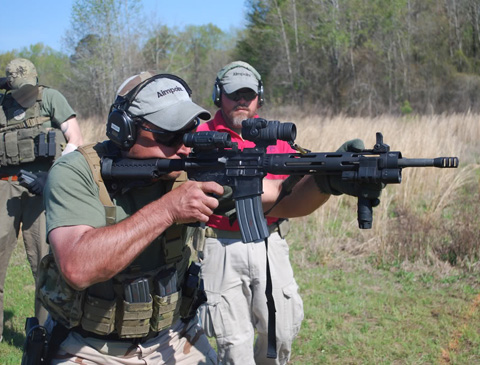
Kyle Lamb and Smith & Wesson update the VTAC Rifle with new Geiselle trigger, Troy rail, more. (photos are VTac Rifle 1)
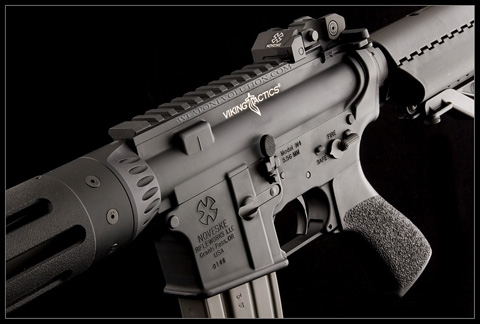
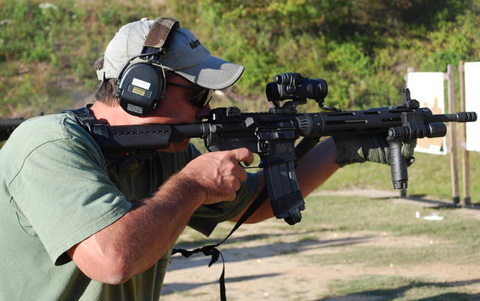
NEWS ARCHIVES


Kyle Lamb and Smith & Wesson update the VTAC Rifle with new Geiselle trigger, Troy rail, more. (photos are VTac Rifle 1)


NEWS ARCHIVES

Posted by echigoyaworks
at 10:00
2012年07月26日
Sig Sauer 1911 Tactical Ops
私たちのブログを訪問していただきありがとうございます。あなたがお持ちの場合DIYの要求は私達に電子メールを送信してください。
Swiss twist on a classic design with features that today’s SWAT officers demand!
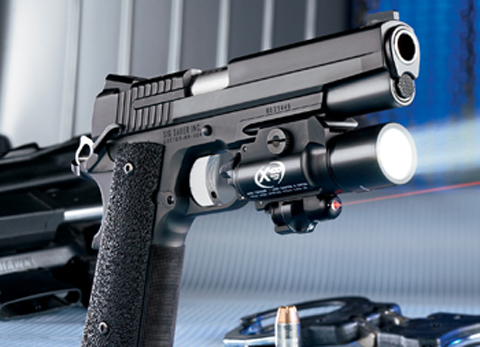
Sig Sauer’s 1911 Tactical Operations pistol is as reliable as it is versatile, shown here with a SureFire X400.
The most enduring design of John Browning remains the 1911 pistol. In fact, a good argument can be made that the 1911 is the most timeless handgun of all time. Taking that position one step further, you would be very hard-pressed to come up with another technological innovation introduced 100 years ago that remains on the cutting edge today. For the better part of the 20th century, commercially made 1911s were only available from a single source. That has all changed and 1911 pistols are now available from a number of manufacturers. However, quality varies tremendously and in the end you’ll get exactly what you paid for.
A few years ago, Sig Sauer introduced a line of 1911 pistols, a move that took many of us by surprise. After all, Sig Sauer was turning out some first rate DA pistols. Why make a move into unknown territory? Why not? If this firm could turn out a world class DA pistol, they just might be able to apply that expertise to the most popular self-loading pistol of all time.
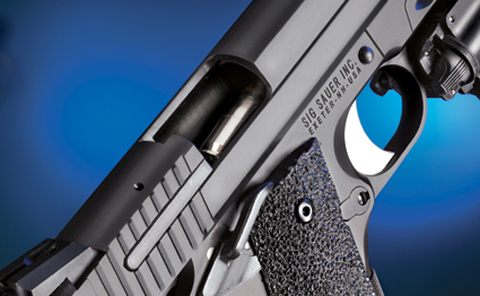
Ambi safety is standard on the Sig Tactical Operations pistol.
Recently, I was able to check out a Sig Sauer 1911 Tactical Operations pistol chambered in .45 ACP. The Tactical Operations pistol is a full-size, all-steel 1911 pistol that has everything you need and nothing you don’t. As its name implies, this heavy-duty pistol is designed for the SWAT officer, but would also be a solid choice for patrol or personal defense.
Like all Sig Sauer 1911 pistols, the Tactical Operations embodies the classic qualities of the Browning original along with modern innovation.
BLOG ARCHIVES

Swiss twist on a classic design with features that today’s SWAT officers demand!

Sig Sauer’s 1911 Tactical Operations pistol is as reliable as it is versatile, shown here with a SureFire X400.
The most enduring design of John Browning remains the 1911 pistol. In fact, a good argument can be made that the 1911 is the most timeless handgun of all time. Taking that position one step further, you would be very hard-pressed to come up with another technological innovation introduced 100 years ago that remains on the cutting edge today. For the better part of the 20th century, commercially made 1911s were only available from a single source. That has all changed and 1911 pistols are now available from a number of manufacturers. However, quality varies tremendously and in the end you’ll get exactly what you paid for.
A few years ago, Sig Sauer introduced a line of 1911 pistols, a move that took many of us by surprise. After all, Sig Sauer was turning out some first rate DA pistols. Why make a move into unknown territory? Why not? If this firm could turn out a world class DA pistol, they just might be able to apply that expertise to the most popular self-loading pistol of all time.

Ambi safety is standard on the Sig Tactical Operations pistol.
Recently, I was able to check out a Sig Sauer 1911 Tactical Operations pistol chambered in .45 ACP. The Tactical Operations pistol is a full-size, all-steel 1911 pistol that has everything you need and nothing you don’t. As its name implies, this heavy-duty pistol is designed for the SWAT officer, but would also be a solid choice for patrol or personal defense.
Like all Sig Sauer 1911 pistols, the Tactical Operations embodies the classic qualities of the Browning original along with modern innovation.
BLOG ARCHIVES

Posted by echigoyaworks
at 21:00
2012年07月26日
JP Enterprises PSC-11
私たちのブログを訪問していただきありがとうございます。あなたがお持ちの場合DIYの要求は私達に電子メールを送信してください。
Built and bred for battle—high-end match-grade combat rifle!

With a reputation like JP Enterprises’, the PSC-11 lives up to its predecessors’ ability for first-shot accuracy, and it definitely has the ability to pile bullets into tight groups when it runs hot, too.
When I first held JP Enterprises’ new PSC-11 rifle in my hands last year, my first thought was that somebody left one of their JPE CTR-02s and an LRP-07 in a dark corner of the shop, put on some mood music and let nature take its course. In reality, John Paul, the owner of JP Enterprises, listened to requests from shooters who wanted a high-quality, accurate AR upper to fit their lower receivers. It wasn’t too much of a stretch to take the best features of the LRP-07 and blend them with a CTR-02 to create the new rifle.

This JPE PSC-11 is tricked out with a 4.5-14x Leupold Mark 4, Accu-Shot’s high-grade monopod, Atlas bipod, and Magpul’s PRS buttstock, adjustable grip and magazine. The rifle’s .223 Wylde chambering lies between the .223 and 5.56mm NATO dimensions, boosting versatility.
“With the introduction of our new SCR-11 platform, we knew serious shooters would want to incorporate the JP side-charge system into their existing small-frame gas gun,” John Paul said. “That’s why we are introduced the new PSC-11 in 2011. This upper combines all the great features and performance of the new SCR-11 in a package that is cross-compatible with any standard lower receiver on the market. This new upper system is designed for the all-out tactical market with redundant side and top charging systems, dust cover, forward assist and an optional key-slot gas plug for those running suppressed systems.”

Shoulder-mounted charging is quick and easy with JPE’s side-charge system, but if you’re a traditionalist, it still has a standard AR charging handle.
BLOG ARCHIVES

Built and bred for battle—high-end match-grade combat rifle!

With a reputation like JP Enterprises’, the PSC-11 lives up to its predecessors’ ability for first-shot accuracy, and it definitely has the ability to pile bullets into tight groups when it runs hot, too.
When I first held JP Enterprises’ new PSC-11 rifle in my hands last year, my first thought was that somebody left one of their JPE CTR-02s and an LRP-07 in a dark corner of the shop, put on some mood music and let nature take its course. In reality, John Paul, the owner of JP Enterprises, listened to requests from shooters who wanted a high-quality, accurate AR upper to fit their lower receivers. It wasn’t too much of a stretch to take the best features of the LRP-07 and blend them with a CTR-02 to create the new rifle.

This JPE PSC-11 is tricked out with a 4.5-14x Leupold Mark 4, Accu-Shot’s high-grade monopod, Atlas bipod, and Magpul’s PRS buttstock, adjustable grip and magazine. The rifle’s .223 Wylde chambering lies between the .223 and 5.56mm NATO dimensions, boosting versatility.
“With the introduction of our new SCR-11 platform, we knew serious shooters would want to incorporate the JP side-charge system into their existing small-frame gas gun,” John Paul said. “That’s why we are introduced the new PSC-11 in 2011. This upper combines all the great features and performance of the new SCR-11 in a package that is cross-compatible with any standard lower receiver on the market. This new upper system is designed for the all-out tactical market with redundant side and top charging systems, dust cover, forward assist and an optional key-slot gas plug for those running suppressed systems.”

Shoulder-mounted charging is quick and easy with JPE’s side-charge system, but if you’re a traditionalist, it still has a standard AR charging handle.
BLOG ARCHIVES

Posted by echigoyaworks
at 16:00
2012年07月26日
Remington M40-XS .338 Lapua Magnum
私たちのブログを訪問していただきありがとうございます。あなたがお持ちの場合DIYの要求は私達に電子メールを送信してください。
Precision performance for the LE Designated Marksman with devastating punch!
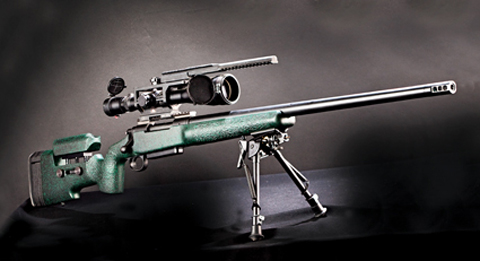
Remington 40-XS in .338 Lapua bridges the gap between .308 and .50 BMG in a state of the art bolt action rifle that delivers the goods in terms of both accuracy and terminal ballistics.
THE .338 Lapua Mag is a precision tactical cartridge whose time has come. Originally developed in 1983 at the request of the U.S. Navy, the .338 uses a necked down .416 Rigby case and in its initial configuration launched a 250-grain bullet at nearly 3,000 feet per second (fps) with a muzzle energy of over 4,800 foot pounds of energy (fpe). Research Armament produced a prototype rifle and ammunition that were tested by the Navy, but the cartridge never was put into production in the United States. Lapua and Norma finished development of the .338 and began manufacturing the cartridge under the Lapua name. Besides Lapua, Black Hills also loads both 250- and 300-grain cartridges. The latter bullet leaves the muzzle at 2,800 fps with a prodigious 5,223 fpe. To put this into perspective, a 168-grain .308 match cartridge has a muzzle velocity of only about 2,600 fps and 2,180 fpe. The .308’s ballistics pale in comparison to the .338 Lapua, although most .338 rifles are only marginally heavier than precision tactical rifles chambered for the .308.

When raised up, the McMillan A5’s adjustable cheekpiece is designed not to conflict with the “bolt throw” of the host rifle.
The Remington Model 40-XS, for example, is only slightly larger and heavier than similar rifles in smaller calibers, weighing in at 16 pounds — complete with scope and bipod. The test rifle uses Remington’s Model 40-XS action in a McMillan A5 stock. Naturally, a large cartridge like the .338 will necessarily deliver more felt recoil than lesser cartridges, but this can be offset by the use of muzzle brakes. The Remington muzzle brake reduces felt recoil to approximately that of a .308, although muzzle blast alongside the rifle is significant. The spotter on a precision tactical team using a Remington 40-XS .338 Lapua Mag should position himself slightly to the rear of the shooter’s shoulder to avoid having gases and dust blown into his face. As the .338 Lapua Mag became accepted by a number of the world’s military forces as replacements for, or supplements to bridge the gap between the .308 and .50 BMG, it was only a matter of time before law enforcement began to consider it. The .338 gives the precision tactical marksman a huge range advantage over any .308 caliber rifle, while adding little to the weight burden that every rifleman must contend with. As mentioned, the test rifle weighs only 16 pounds (fully loaded) and I’ve tested .308 caliber precision tactical rifles that weigh about the same. When compared to .50 BMG caliber rifles, the Remington 40-XS weighs nearly 10 pounds less than the lightest weight .50 BMG rifle I’ve ever tested. Most .50 BMG rifles, like the widely used Barrett M82, weigh over 30 pounds.

The aggressively designed muzzle brake of the 40-XS helped tame the recoil of the .338 Lapua Mag chambering down to manageable .308 levels.
BLOG ARCHIVES

Precision performance for the LE Designated Marksman with devastating punch!

Remington 40-XS in .338 Lapua bridges the gap between .308 and .50 BMG in a state of the art bolt action rifle that delivers the goods in terms of both accuracy and terminal ballistics.
THE .338 Lapua Mag is a precision tactical cartridge whose time has come. Originally developed in 1983 at the request of the U.S. Navy, the .338 uses a necked down .416 Rigby case and in its initial configuration launched a 250-grain bullet at nearly 3,000 feet per second (fps) with a muzzle energy of over 4,800 foot pounds of energy (fpe). Research Armament produced a prototype rifle and ammunition that were tested by the Navy, but the cartridge never was put into production in the United States. Lapua and Norma finished development of the .338 and began manufacturing the cartridge under the Lapua name. Besides Lapua, Black Hills also loads both 250- and 300-grain cartridges. The latter bullet leaves the muzzle at 2,800 fps with a prodigious 5,223 fpe. To put this into perspective, a 168-grain .308 match cartridge has a muzzle velocity of only about 2,600 fps and 2,180 fpe. The .308’s ballistics pale in comparison to the .338 Lapua, although most .338 rifles are only marginally heavier than precision tactical rifles chambered for the .308.

When raised up, the McMillan A5’s adjustable cheekpiece is designed not to conflict with the “bolt throw” of the host rifle.
The Remington Model 40-XS, for example, is only slightly larger and heavier than similar rifles in smaller calibers, weighing in at 16 pounds — complete with scope and bipod. The test rifle uses Remington’s Model 40-XS action in a McMillan A5 stock. Naturally, a large cartridge like the .338 will necessarily deliver more felt recoil than lesser cartridges, but this can be offset by the use of muzzle brakes. The Remington muzzle brake reduces felt recoil to approximately that of a .308, although muzzle blast alongside the rifle is significant. The spotter on a precision tactical team using a Remington 40-XS .338 Lapua Mag should position himself slightly to the rear of the shooter’s shoulder to avoid having gases and dust blown into his face. As the .338 Lapua Mag became accepted by a number of the world’s military forces as replacements for, or supplements to bridge the gap between the .308 and .50 BMG, it was only a matter of time before law enforcement began to consider it. The .338 gives the precision tactical marksman a huge range advantage over any .308 caliber rifle, while adding little to the weight burden that every rifleman must contend with. As mentioned, the test rifle weighs only 16 pounds (fully loaded) and I’ve tested .308 caliber precision tactical rifles that weigh about the same. When compared to .50 BMG caliber rifles, the Remington 40-XS weighs nearly 10 pounds less than the lightest weight .50 BMG rifle I’ve ever tested. Most .50 BMG rifles, like the widely used Barrett M82, weigh over 30 pounds.

The aggressively designed muzzle brake of the 40-XS helped tame the recoil of the .338 Lapua Mag chambering down to manageable .308 levels.
BLOG ARCHIVES

Posted by echigoyaworks
at 10:00
2012年07月25日
Tactical Supergrade Wilson Combat
私たちのブログを訪問していただきありがとうございます。あなたがお持ちの場合DIYの要求は私達に電子メールを送信してください。

It is possible to combine breath-taking aesthetics and absolute function in a single pistol and that is exactly what we have done in our finest defensive pistol - the Tactical Supergrade. Hand crafted from carbon steel, the Tactical Supergrade is optimized for use as the ultimate defensive handgun - which happens to have the beauty and workmanship that have made the Wilson Combat® Supergrades the standard to which all other custom pistols are compared. The Tactical Supergrade redefines the term "state of the art" in every way possible. The Tactical Supergrade is simply the finest full-size defensive pistol in today's market.




If you're the discerning individual who requires only the finest in quality materials, design, and craftsmanship, this is the pistol for you.
NEWS ARCHIVES


It is possible to combine breath-taking aesthetics and absolute function in a single pistol and that is exactly what we have done in our finest defensive pistol - the Tactical Supergrade. Hand crafted from carbon steel, the Tactical Supergrade is optimized for use as the ultimate defensive handgun - which happens to have the beauty and workmanship that have made the Wilson Combat® Supergrades the standard to which all other custom pistols are compared. The Tactical Supergrade redefines the term "state of the art" in every way possible. The Tactical Supergrade is simply the finest full-size defensive pistol in today's market.




If you're the discerning individual who requires only the finest in quality materials, design, and craftsmanship, this is the pistol for you.
NEWS ARCHIVES

Posted by echigoyaworks
at 21:00
2012年07月25日
MG4 Full Auto Only Firepower
私たちのブログを訪問していただきありがとうございます。あなたがお持ちの場合DIYの要求は私達に電子メールを送信してください。
Germany’s armed forces adopt HK’s new 5.56mm MG4 lightweight squad auto!
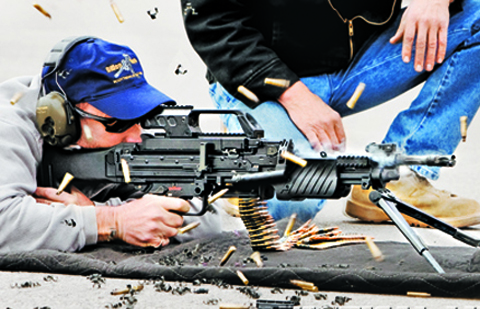
German gun maker Heckler & Koch (HK) is well known for breaking molds. The engineers in Oberndorf are not afraid to blaze new trails with guns like the G36 assault rifle with its polymer construction and integral optics. Note I said “optics,” plural: The G36A1 sports both a red-dot sight and a 4X scope stacked on top each other in a sort of figure 8.
When it came time to upgrade the army’s squad machinegun, the Bundeswehr naturally turned to HK to develop a weapon. Yes, the Germans could have bought M249 SAWs from FN in neighboring Belgium, but that’s not how they operate in Europe’s foremost manufacturing country. The Bundeswehr wanted a German gun. I can’t blame them at all. In a quick digression, I note with alarm that America’s military cares not a whit about sustaining our own domestic small-arms development capability.
We bought Beretta pistols from Italy. We awarded FN the contract to develop the SCAR. Glock pistols were recently bought by the hundreds of thousands to give to Iraqi cops. I would like to see our military try a little “buy at home” for a change, like the Germans do.
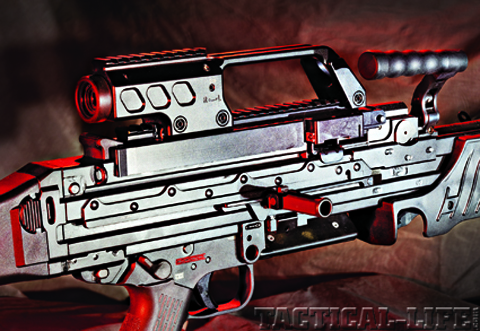
And so HK was tasked with developing a SAW-like weapon: a belt-fed 5.56mm light machinegun that can be adapted for an assault mode as well as a fixed position mode (i.e., tripod mounted). The result was the MG43 which first appeared in 2001 and was later type-classified and adopted by the Budeswehr as the MG4. By 2007, the MG4 had replaced the previous MG3, a 7.62mm machinegun, on vehicles and for ground troops.
The MG4 is a definite departure for HK as it’s a conventional gas-operated, rotary cam design whereas previous German machineguns have relied on the distinctive Vorgrimler-designed roller-delayed blowback action.
BLOG ARCHIVES

Germany’s armed forces adopt HK’s new 5.56mm MG4 lightweight squad auto!

German gun maker Heckler & Koch (HK) is well known for breaking molds. The engineers in Oberndorf are not afraid to blaze new trails with guns like the G36 assault rifle with its polymer construction and integral optics. Note I said “optics,” plural: The G36A1 sports both a red-dot sight and a 4X scope stacked on top each other in a sort of figure 8.
When it came time to upgrade the army’s squad machinegun, the Bundeswehr naturally turned to HK to develop a weapon. Yes, the Germans could have bought M249 SAWs from FN in neighboring Belgium, but that’s not how they operate in Europe’s foremost manufacturing country. The Bundeswehr wanted a German gun. I can’t blame them at all. In a quick digression, I note with alarm that America’s military cares not a whit about sustaining our own domestic small-arms development capability.
We bought Beretta pistols from Italy. We awarded FN the contract to develop the SCAR. Glock pistols were recently bought by the hundreds of thousands to give to Iraqi cops. I would like to see our military try a little “buy at home” for a change, like the Germans do.

And so HK was tasked with developing a SAW-like weapon: a belt-fed 5.56mm light machinegun that can be adapted for an assault mode as well as a fixed position mode (i.e., tripod mounted). The result was the MG43 which first appeared in 2001 and was later type-classified and adopted by the Budeswehr as the MG4. By 2007, the MG4 had replaced the previous MG3, a 7.62mm machinegun, on vehicles and for ground troops.
The MG4 is a definite departure for HK as it’s a conventional gas-operated, rotary cam design whereas previous German machineguns have relied on the distinctive Vorgrimler-designed roller-delayed blowback action.
BLOG ARCHIVES

Posted by echigoyaworks
at 16:00
2012年07月25日
D&L Sports Perimeter Carbine 5.56mm
私たちのブログを訪問していただきありがとうございます。あなたがお持ちの場合DIYの要求は私達に電子メールを送信してください。
Extremely high-precision downrange dominator with sniper rifle accuracy!
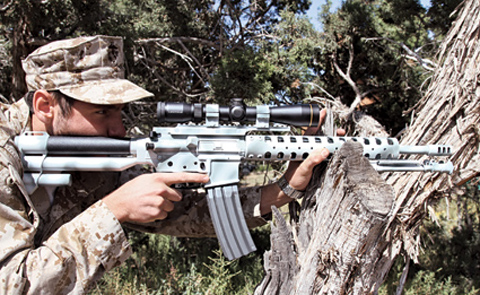
This U.S. Marine loved the D&L PPC and the SureFire 60-round mag shown here. He will soon deploy and wishes he could take both with him.
Quite alive and well, the old slogan “buyer beware” pertains to, well, everything we buy. A life-long, daily risk management drill, you ask? You bet, and firearms are certainly no exception. Take the AR-15 platform, but don’t try to count all the clones or you may hurt your eyes, as they can run the gamut of the good, bad and the ugly. Did you hear about the small quantity of aftermarket ARs last year that were equipped with bolts made in Turkey? Except for the bolts, the guns were fine. Sure, you can cut corners, but not at the corner of “bolt and carrier.” When you do, a big accident is waiting to happen.
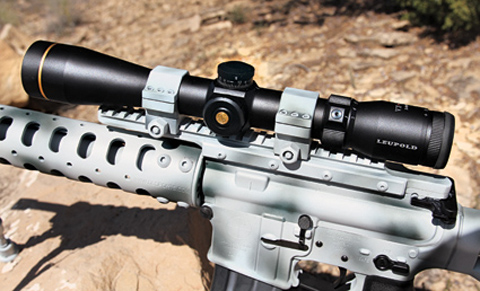
Using four mounting bolts, D&L’s receiver scope base is extremely secure, as is its eight-bolt handguard and 60-screw 30mm scope rings.
Case in point, an accident occurred while in the hands of a police officer who was the (short-lived) proud owner of the new AR clone. Fortunately, God was at the range when all six lugs sheered off, allowing the bolt to blow rearward without rotating. The upper receiver was destroyed and all other upper parts, except the barrel, were ready for a dirt nap. The lower suffered no damage and, most importantly, the police officer suffered only a face speckled by tiny aluminum shards, with his glasses saving his eyes. Yes, you can get what you pay for, but sometimes it’s worth less than the asking price.
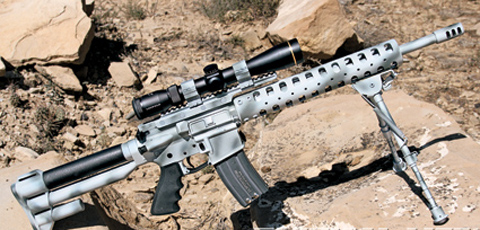
Even without its winter plumage, D&L’s Professional Perimeter Carbine would stand out in a crowd. Many of its features are unique to D&L Sports, including its aluminum stock, free-floating, ventilated handguard, and muzzle brake/flash suppressor. The scope tested with the rifle was a Leupold 3-9×42mm.
When compared with some, the AR-15-type rifle is a highly technical rifle; not only in design, but also in the mil-spec requirements assuring that it is made of the finest materials to the highest quality control. It isn’t rocket science, but it is vital to the operation and safety of rifle and operator.
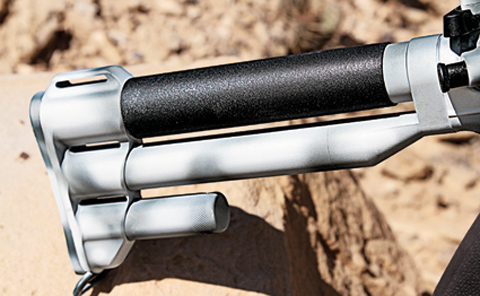
Built to endure harsh usage, D&L’s aluminum AR buttstock comes with two waterproof storage tubes. They also make an adjustable length-of-pull version.
BLOG ARCHIVES

Extremely high-precision downrange dominator with sniper rifle accuracy!

This U.S. Marine loved the D&L PPC and the SureFire 60-round mag shown here. He will soon deploy and wishes he could take both with him.
Quite alive and well, the old slogan “buyer beware” pertains to, well, everything we buy. A life-long, daily risk management drill, you ask? You bet, and firearms are certainly no exception. Take the AR-15 platform, but don’t try to count all the clones or you may hurt your eyes, as they can run the gamut of the good, bad and the ugly. Did you hear about the small quantity of aftermarket ARs last year that were equipped with bolts made in Turkey? Except for the bolts, the guns were fine. Sure, you can cut corners, but not at the corner of “bolt and carrier.” When you do, a big accident is waiting to happen.

Using four mounting bolts, D&L’s receiver scope base is extremely secure, as is its eight-bolt handguard and 60-screw 30mm scope rings.
Case in point, an accident occurred while in the hands of a police officer who was the (short-lived) proud owner of the new AR clone. Fortunately, God was at the range when all six lugs sheered off, allowing the bolt to blow rearward without rotating. The upper receiver was destroyed and all other upper parts, except the barrel, were ready for a dirt nap. The lower suffered no damage and, most importantly, the police officer suffered only a face speckled by tiny aluminum shards, with his glasses saving his eyes. Yes, you can get what you pay for, but sometimes it’s worth less than the asking price.

Even without its winter plumage, D&L’s Professional Perimeter Carbine would stand out in a crowd. Many of its features are unique to D&L Sports, including its aluminum stock, free-floating, ventilated handguard, and muzzle brake/flash suppressor. The scope tested with the rifle was a Leupold 3-9×42mm.
When compared with some, the AR-15-type rifle is a highly technical rifle; not only in design, but also in the mil-spec requirements assuring that it is made of the finest materials to the highest quality control. It isn’t rocket science, but it is vital to the operation and safety of rifle and operator.

Built to endure harsh usage, D&L’s aluminum AR buttstock comes with two waterproof storage tubes. They also make an adjustable length-of-pull version.
BLOG ARCHIVES

Posted by echigoyaworks
at 10:00
2012年07月24日
Springfield .45 Professional
私たちのブログを訪問していただきありがとうございます。あなたがお持ちの場合DIYの要求は私達に電子メールを送信してください。
Fighting 1911 that overcame rigorous testing to become the FBI’s “go-to” tactical pistol!
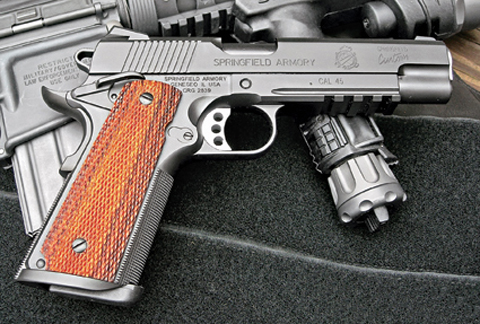
Every feature of the Professional Model was specified in the RFP by the Bureau, and each submission for the original FBI contract was required to meet demanding endurance and accuracy requirements.
When the FBI adopted the Springfield Professional 1911 in 1998, new respect was bestowed on the old workhorse. The Professional is the result of a Request for Proposal (RFP) that was issued in 1995 in an effort to standardize the pistol for all of their regional SWAT operators. The RFP was extremely demanding and considered by some to be unreasonable. While half a dozen or so manufacturers and shops submitted guns, there would only be one winner. One of those vying for a chance at the contract was Dave Williams, Springfield’s Custom Shop Director.
Origins
At first glance, the Professional may not seem all that unique or different but, in 1998, it set the world on fire. After all, the country’s “premier law enforcement agency” had chosen a design that was some 90 years old. For those who are not familiar with this pistol, the Professional Model is a single-stack 1911 pistol that is built entirely in Springfield’s Custom Shop. The slide and frame start as semi-finished parts and the shop’s staff cut the rails, drill the pin holes and hand fit every part.
The Bureau specified Novak low-mount tritium sights, an extended ambidextrous safety, beavertail grip safety, magazine well, 20-lines-per-inch checkered frontstrap, and match-grade internal components. The proposal also called for Walter Birdsong’s Black- T finish and required the pistols to be shipped with five Wilson 47D 8-round magazines. On top of all this, the manufacturer was required to warranty the pistol for an astounding 50,000 rounds.
BLOG ARCHIVES

Fighting 1911 that overcame rigorous testing to become the FBI’s “go-to” tactical pistol!

Every feature of the Professional Model was specified in the RFP by the Bureau, and each submission for the original FBI contract was required to meet demanding endurance and accuracy requirements.
When the FBI adopted the Springfield Professional 1911 in 1998, new respect was bestowed on the old workhorse. The Professional is the result of a Request for Proposal (RFP) that was issued in 1995 in an effort to standardize the pistol for all of their regional SWAT operators. The RFP was extremely demanding and considered by some to be unreasonable. While half a dozen or so manufacturers and shops submitted guns, there would only be one winner. One of those vying for a chance at the contract was Dave Williams, Springfield’s Custom Shop Director.
Origins
At first glance, the Professional may not seem all that unique or different but, in 1998, it set the world on fire. After all, the country’s “premier law enforcement agency” had chosen a design that was some 90 years old. For those who are not familiar with this pistol, the Professional Model is a single-stack 1911 pistol that is built entirely in Springfield’s Custom Shop. The slide and frame start as semi-finished parts and the shop’s staff cut the rails, drill the pin holes and hand fit every part.
The Bureau specified Novak low-mount tritium sights, an extended ambidextrous safety, beavertail grip safety, magazine well, 20-lines-per-inch checkered frontstrap, and match-grade internal components. The proposal also called for Walter Birdsong’s Black- T finish and required the pistols to be shipped with five Wilson 47D 8-round magazines. On top of all this, the manufacturer was required to warranty the pistol for an astounding 50,000 rounds.
BLOG ARCHIVES

Posted by echigoyaworks
at 21:00
2012年07月24日
Sionics Weapon Systems SAR -15-QR10
私たちのブログを訪問していただきありがとうございます。あなたがお持ちの場合DIYの要求は私達に電子メールを送信してください。
Designed by operators for operators with all the features that patrol officers need!
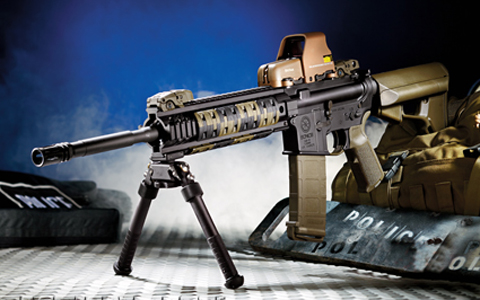
The Sionics SAR-15-QR10 offers true no-nonsense Mil-Spec quality at the right price for today’s law enforcement needs. It is shown equipped with an EOTech 553.A65TAN HWS and Atlas Precision BT10 bipod.
Sionics Weapon Systems is a fairly new AR rifle manufacturer that is committed to delivering the highest quality Mil-Spec no-nonsense guns at the lowest possible price. And judging by its SAR-15-QR10 rifle, I would say they have succeeded.
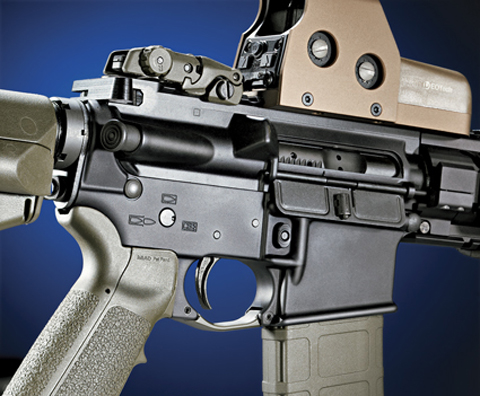
Sionics SAR-15-QR10 exhibited tight tolerances between the upper and lower receivers and an excellent finish.
The staff and management at Sionics is made up of former military and law enforcement personnel who know what it means to depend on your weapon system. Josh Ellis, the owner of Sionics, has worked closely with many police armorers to ensure that his rifle meets their needs. It has been extensively tested and approved by the Tucson Police Department as a patrol rifle. According to Ellis, Sionics rifles are being used by federal agents as well as being currently evaluated by several law enforcement agencies.
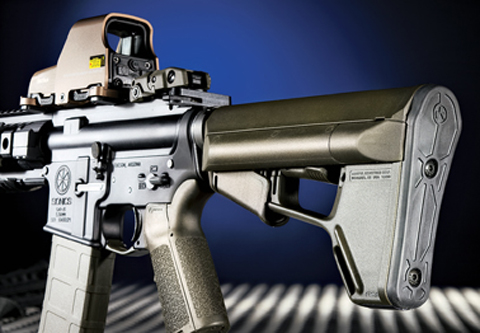
The SAR-15-QR10 sports an olive drab Magpul ACS carbine stock, MIAD pistol grip, MOE enlarged triggerguard, XTM rail panels, PMag and MBUS flip-up front and rear sights.
The SAR-15 is a direct gas impingement 5.56mm NATO semi-auto rifle exhibiting above standard quality. The fit and finish and attention to detail are equivalent to what one would expect from a custom gun shop and with some extras as well.
BLOG ARCHIVES

Designed by operators for operators with all the features that patrol officers need!

The Sionics SAR-15-QR10 offers true no-nonsense Mil-Spec quality at the right price for today’s law enforcement needs. It is shown equipped with an EOTech 553.A65TAN HWS and Atlas Precision BT10 bipod.
Sionics Weapon Systems is a fairly new AR rifle manufacturer that is committed to delivering the highest quality Mil-Spec no-nonsense guns at the lowest possible price. And judging by its SAR-15-QR10 rifle, I would say they have succeeded.

Sionics SAR-15-QR10 exhibited tight tolerances between the upper and lower receivers and an excellent finish.
The staff and management at Sionics is made up of former military and law enforcement personnel who know what it means to depend on your weapon system. Josh Ellis, the owner of Sionics, has worked closely with many police armorers to ensure that his rifle meets their needs. It has been extensively tested and approved by the Tucson Police Department as a patrol rifle. According to Ellis, Sionics rifles are being used by federal agents as well as being currently evaluated by several law enforcement agencies.

The SAR-15-QR10 sports an olive drab Magpul ACS carbine stock, MIAD pistol grip, MOE enlarged triggerguard, XTM rail panels, PMag and MBUS flip-up front and rear sights.
The SAR-15 is a direct gas impingement 5.56mm NATO semi-auto rifle exhibiting above standard quality. The fit and finish and attention to detail are equivalent to what one would expect from a custom gun shop and with some extras as well.
BLOG ARCHIVES

Posted by echigoyaworks
at 16:00
2012年07月24日
Wilson Combat SBR Tactical 7.62×40 WT
私たちのブログを訪問していただきありがとうございます。あなたがお持ちの場合DIYの要求は私達に電子メールを送信してください。
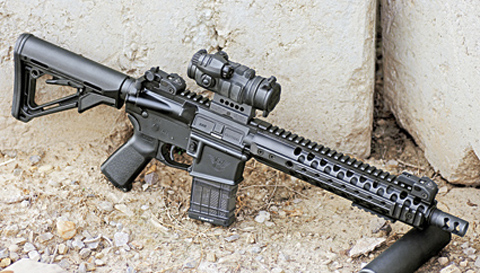
Wilson Combat’s SBR Tactical is extremely powerful yet easy to maneuver with in close quarters. Wilson’s proprietary 7.62×40 WT cartridge has just the right amount of knockdown power to pair with the SBR’s barrel. This is truly a versatile platform. Shown here with an Aimpoint CompM3.
New chamberings come and go all the time, and this has always been the nature of the business. Someone is always trying to improve on existing cartridges, platforms and systems. It is this innovation that makes the firearms industry as strong as it is.
One of the longest standing of these projects has been the short .30 caliber for the AR platform. Since the first time a U.S. soldier fought against the AK-47 and its 7.62×39mm cartridge, the industry has tried to make that round (or one like it) work in an AR. It is a project that continues to this day, resulting in cartridges like the 300 AAC Blackout, .300 Whisper and a few others. They are all an attempt to approximate the ballistics of the 7.62×39mm and function properly in an AR-type rifle. For most, that is as close to 2,400 feet per second (fps) as you can get with a 125-grain bullet. New powders, bullets and precise manufacturing have made this better with each passing year. But getting these cartridges to fire has never really been the issue—it has been getting them to work in magazines.
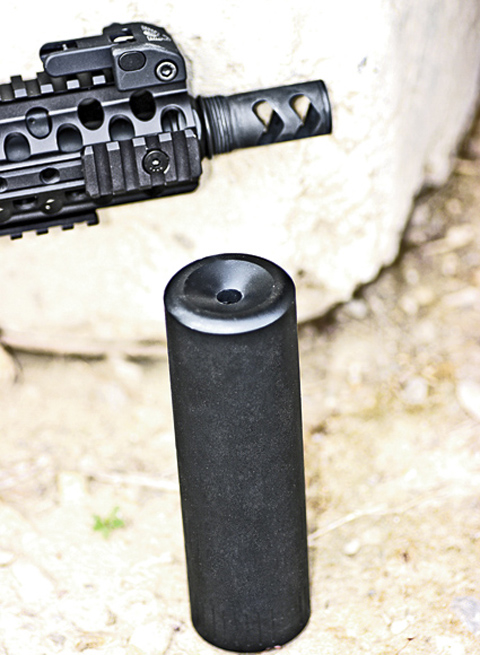
The Wilson Combat Whisper762 suppressor does little to affect the balance of the SBR Tactical—it’s lightweight, quiet, and reliable. During range tests, the suppressor showed no signs of shifting the point of impact. It provided minimal backpressure, never came loose, and maintained excellent sound suppression.
Take a close look at an AK-47 magazine. It curves almost immediately. Other than the lip of the magazine, about an inch or so, it is one continuous curve. This is necessary for the ammunition to feed properly past about ten rounds, given the cartridge diameter. You could make a straight magazine, of course, but it would be too long to be practical, and still presents its own set of issues. You need the curve in order to make it practical with a 30-round magazine—even for a 20- or 25-rounder. Without this curve, the rounds will bunch up in the middle and cause malfunctions. It is just one of those laws of physics that cannot be circumvented.
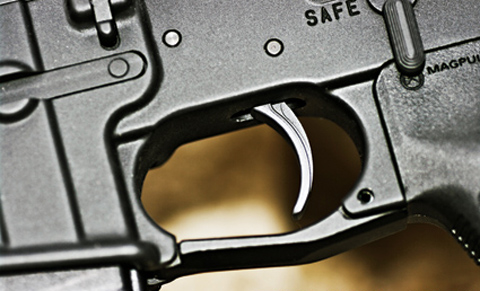
Wilson builds their SBR with their TTU (Tactical Trigger Unit), which provides operators with a clean two-stage trigger.
BLOG ARCHIVES


Wilson Combat’s SBR Tactical is extremely powerful yet easy to maneuver with in close quarters. Wilson’s proprietary 7.62×40 WT cartridge has just the right amount of knockdown power to pair with the SBR’s barrel. This is truly a versatile platform. Shown here with an Aimpoint CompM3.
New chamberings come and go all the time, and this has always been the nature of the business. Someone is always trying to improve on existing cartridges, platforms and systems. It is this innovation that makes the firearms industry as strong as it is.
One of the longest standing of these projects has been the short .30 caliber for the AR platform. Since the first time a U.S. soldier fought against the AK-47 and its 7.62×39mm cartridge, the industry has tried to make that round (or one like it) work in an AR. It is a project that continues to this day, resulting in cartridges like the 300 AAC Blackout, .300 Whisper and a few others. They are all an attempt to approximate the ballistics of the 7.62×39mm and function properly in an AR-type rifle. For most, that is as close to 2,400 feet per second (fps) as you can get with a 125-grain bullet. New powders, bullets and precise manufacturing have made this better with each passing year. But getting these cartridges to fire has never really been the issue—it has been getting them to work in magazines.

The Wilson Combat Whisper762 suppressor does little to affect the balance of the SBR Tactical—it’s lightweight, quiet, and reliable. During range tests, the suppressor showed no signs of shifting the point of impact. It provided minimal backpressure, never came loose, and maintained excellent sound suppression.
Take a close look at an AK-47 magazine. It curves almost immediately. Other than the lip of the magazine, about an inch or so, it is one continuous curve. This is necessary for the ammunition to feed properly past about ten rounds, given the cartridge diameter. You could make a straight magazine, of course, but it would be too long to be practical, and still presents its own set of issues. You need the curve in order to make it practical with a 30-round magazine—even for a 20- or 25-rounder. Without this curve, the rounds will bunch up in the middle and cause malfunctions. It is just one of those laws of physics that cannot be circumvented.

Wilson builds their SBR with their TTU (Tactical Trigger Unit), which provides operators with a clean two-stage trigger.
BLOG ARCHIVES

Posted by echigoyaworks
at 10:00
2012年07月23日
Marine Air Wing using Leupold HAMR
私たちのブログを訪問していただきありがとうございます。あなたがお持ちの場合DIYの要求は私達に電子メールを送信してください。
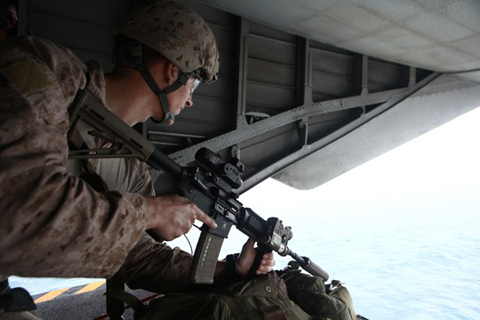
Apparently the Marine Air Wing, America's Navy's Army's Air Force, are using the new Leupold HAMR scope. Its combination of long eye relief and compact size make it a good choice for ariel overwatch. The Marine Air Wingers also appear to be Magpul fans, using Magpul stocks and magazines.
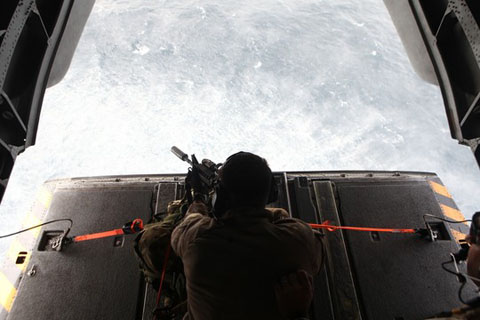
The Leupold HAMR is said to be part of the SOPMOD Block II kit which is currently under development.
BLOG ARCHIVES


Apparently the Marine Air Wing, America's Navy's Army's Air Force, are using the new Leupold HAMR scope. Its combination of long eye relief and compact size make it a good choice for ariel overwatch. The Marine Air Wingers also appear to be Magpul fans, using Magpul stocks and magazines.

The Leupold HAMR is said to be part of the SOPMOD Block II kit which is currently under development.
BLOG ARCHIVES

Posted by echigoyaworks
at 21:00
2012年07月23日
Nemesis Vanquish
私たちのブログを訪問していただきありがとうございます。あなたがお持ちの場合DIYの要求は私達に電子メールを送信してください。
From up-armored briefcase to DOA precision in 60 seconds or less!
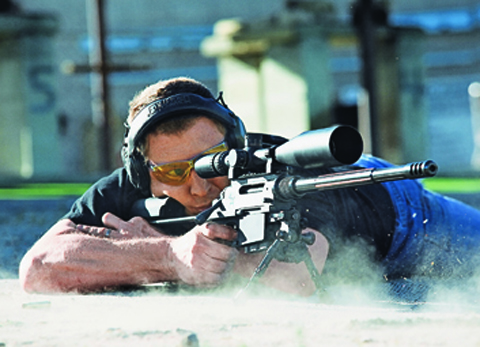
For many years, the .308 Winchester has been a major cartridge of choice for snipers. Combined with the Vanquish, the .308 Win. improves your odds for precise, long-range hits.
Since the American Revolution, our military has used the marksman, a sniper in today’s terminology, to great effect on the battlefield. It may not have been considered gentlemanly at the time, especially by the neat phalanxes of Redcoats who complained about the rebels fighting from behind concealment and cover like Indians, but the results would override any objections. By the American Civil War, the marksman was entrenched in the tactics of warfare with his properties of stealth and long-range accuracy. Enemies were no longer safe even far from the frontlines. Over time, the mission of the sniper has basically stayed the same, aside from also being tasked as a scout or observer because of his forward deployment, but there have been changes in both his methods and equipment. The most notable changes have been made to the sniper’s main weapon, the rifle.
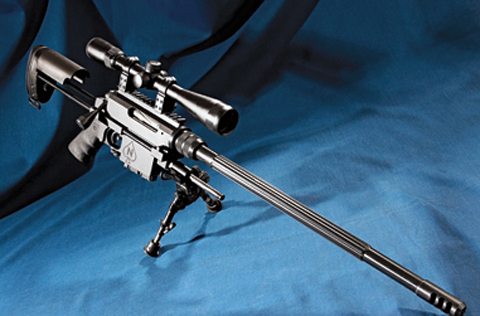
The Vanquish is a purpose-built rifle with all components tuned to provide the best function and accuracy. It may look stark, but it will bring out the best in the ammunition and the shooter.
The marksmen of the Revolution mainly used their personal firearms, most often hunting rifles, because they were more accurate than the military muskets of the day. Over the years, improvement to military arms has led to improvement in sporting arms and vice versa, to the point where the sniper’s rifle has usually been one of two types: either a sporting arm adapted to handle the rigors of the battlefield, or a military rifle modified to improve accuracy. Only towards the end of the 20th century did we see rifles that were purpose-built for use by the American sniper. I am not talking about the Remington 700s or the Winchester 70s, since these were sporting rifles at birth, but the larger .50-caliber rifles built by firms such as Barrett.
It is in this arena of modern weapons that Nemesis Arms has made a grand entrance with the manufacture of the Vanquish. The Vanquish is designed from the ground up as the ultimate mid-caliber weapon for the modern sniper.
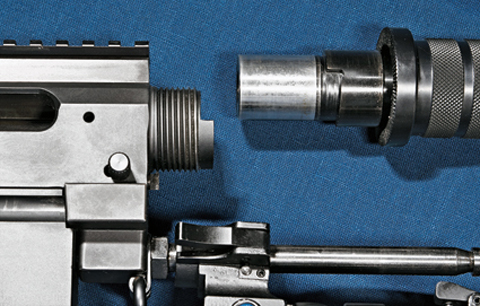
The barrel is a slip-fit into the receiver and then held in place by a threaded nut. The spring-loaded plunger, seen below the threads, assures everything stays together.
BLOG ARCHIVES

From up-armored briefcase to DOA precision in 60 seconds or less!

For many years, the .308 Winchester has been a major cartridge of choice for snipers. Combined with the Vanquish, the .308 Win. improves your odds for precise, long-range hits.
Since the American Revolution, our military has used the marksman, a sniper in today’s terminology, to great effect on the battlefield. It may not have been considered gentlemanly at the time, especially by the neat phalanxes of Redcoats who complained about the rebels fighting from behind concealment and cover like Indians, but the results would override any objections. By the American Civil War, the marksman was entrenched in the tactics of warfare with his properties of stealth and long-range accuracy. Enemies were no longer safe even far from the frontlines. Over time, the mission of the sniper has basically stayed the same, aside from also being tasked as a scout or observer because of his forward deployment, but there have been changes in both his methods and equipment. The most notable changes have been made to the sniper’s main weapon, the rifle.

The Vanquish is a purpose-built rifle with all components tuned to provide the best function and accuracy. It may look stark, but it will bring out the best in the ammunition and the shooter.
The marksmen of the Revolution mainly used their personal firearms, most often hunting rifles, because they were more accurate than the military muskets of the day. Over the years, improvement to military arms has led to improvement in sporting arms and vice versa, to the point where the sniper’s rifle has usually been one of two types: either a sporting arm adapted to handle the rigors of the battlefield, or a military rifle modified to improve accuracy. Only towards the end of the 20th century did we see rifles that were purpose-built for use by the American sniper. I am not talking about the Remington 700s or the Winchester 70s, since these were sporting rifles at birth, but the larger .50-caliber rifles built by firms such as Barrett.
It is in this arena of modern weapons that Nemesis Arms has made a grand entrance with the manufacture of the Vanquish. The Vanquish is designed from the ground up as the ultimate mid-caliber weapon for the modern sniper.

The barrel is a slip-fit into the receiver and then held in place by a threaded nut. The spring-loaded plunger, seen below the threads, assures everything stays together.
BLOG ARCHIVES

Posted by echigoyaworks
at 16:00
2012年07月23日
KAC’s SR-25 U.S. SPEC OPS
私たちのブログを訪問していただきありがとうございます。あなたがお持ちの場合DIYの要求は私達に電子メールを送信してください。
With the BulletFlight iPod app, marksmen have 900M, cold-bore accuracy in the palm of their hands!

The semi-automatic action allows operators to engage multiple targets. Its similarity in appearance to a standard M-16 diminishes the likelihood of an enemy’s observation of a sniper’s presence during insertions with friendly patrols.
The SR-25 is the weapon platform that ushered in, or was rather a product of, a paradigm shift in the U.S. military’s thinking on sniper weapons. KAC’s (Knight’s Armament Company) SR-25 system has come to the battlefield and provides U.S. Special Operations Forces an accurate, semi-automatic platform with bolt-gun accuracy on multiple targets out to 800 meters, and eliminates the need for snipers to carry a defensive second rifle. Built into the familiar Stoner/AR design, the SR-25 can deliver five shots in five seconds and carries a 20-round magazine, thus surpassing the bolt-action rifle in both rate and duration of fire.
Chambered for the 7.62×51mm (.308) round, the SR-25’s design is both an extension of existing weapons development and a radical step forward. To support and extend the rifle’s battlefield sustainability, 60% of the parts are interchangeable with the AR-15/M16 system. Significant changes begin with the free-floating, match grade barrel that is now delivered in a 20-inch Obermeyer steel alloy and 16-inch chrome plated versions capable of sustained .5 MOA accuracy. The rotating bolt and direct-impingement gas system is based on Eugene Stoner’s designs and evolved further by C. Reed Knight, Jr. In order to both protect the free-floating barrel and accommodate sighting and rail mounted devices, KAC developed the Rail Adapter System II Upper Receiver Extension (RASIIURX). While slight variations exist between the Army, Navy and Marine Corp packages, the SR-25 system is typically outfitted with the 3.5-10×40mm Leupold Mk IV mil-dot scope, Harris bipod and KAC QD suppressor. Variants delivered to U.S. forces include more than 3,000 of the U.S. Army’s M110 SASS (Semi-Automatic Sniper System) and the 3,500 of U.S. Navy’s and Marine Corp’s Mk 11 Mod 0, 1&2. These deliveries are not only for use in the scout/sniper ranks, but are also finding themselves in the grateful hands of an increasing number of Designated Marksmen. Other branches of the U.S. government including the Department of State and Department of Energy have also adopted versions for their respective missions. Both in the hands of the trained sniper and the Designated Marksman, the SR-25 variants have seen direct action with Allied forces for more than six years. David Jones, a retired SEAL sniper who carried the Mk11 Mod 0 throughout two tours in Afghanistan, consistently had 1MOA accuracy out to 1,100 yards.
BLOG ARCHIVES

With the BulletFlight iPod app, marksmen have 900M, cold-bore accuracy in the palm of their hands!

The semi-automatic action allows operators to engage multiple targets. Its similarity in appearance to a standard M-16 diminishes the likelihood of an enemy’s observation of a sniper’s presence during insertions with friendly patrols.
The SR-25 is the weapon platform that ushered in, or was rather a product of, a paradigm shift in the U.S. military’s thinking on sniper weapons. KAC’s (Knight’s Armament Company) SR-25 system has come to the battlefield and provides U.S. Special Operations Forces an accurate, semi-automatic platform with bolt-gun accuracy on multiple targets out to 800 meters, and eliminates the need for snipers to carry a defensive second rifle. Built into the familiar Stoner/AR design, the SR-25 can deliver five shots in five seconds and carries a 20-round magazine, thus surpassing the bolt-action rifle in both rate and duration of fire.
Chambered for the 7.62×51mm (.308) round, the SR-25’s design is both an extension of existing weapons development and a radical step forward. To support and extend the rifle’s battlefield sustainability, 60% of the parts are interchangeable with the AR-15/M16 system. Significant changes begin with the free-floating, match grade barrel that is now delivered in a 20-inch Obermeyer steel alloy and 16-inch chrome plated versions capable of sustained .5 MOA accuracy. The rotating bolt and direct-impingement gas system is based on Eugene Stoner’s designs and evolved further by C. Reed Knight, Jr. In order to both protect the free-floating barrel and accommodate sighting and rail mounted devices, KAC developed the Rail Adapter System II Upper Receiver Extension (RASIIURX). While slight variations exist between the Army, Navy and Marine Corp packages, the SR-25 system is typically outfitted with the 3.5-10×40mm Leupold Mk IV mil-dot scope, Harris bipod and KAC QD suppressor. Variants delivered to U.S. forces include more than 3,000 of the U.S. Army’s M110 SASS (Semi-Automatic Sniper System) and the 3,500 of U.S. Navy’s and Marine Corp’s Mk 11 Mod 0, 1&2. These deliveries are not only for use in the scout/sniper ranks, but are also finding themselves in the grateful hands of an increasing number of Designated Marksmen. Other branches of the U.S. government including the Department of State and Department of Energy have also adopted versions for their respective missions. Both in the hands of the trained sniper and the Designated Marksman, the SR-25 variants have seen direct action with Allied forces for more than six years. David Jones, a retired SEAL sniper who carried the Mk11 Mod 0 throughout two tours in Afghanistan, consistently had 1MOA accuracy out to 1,100 yards.
BLOG ARCHIVES

Posted by echigoyaworks
at 10:00
2012年07月22日
.50 BMGs Battle
私たちのブログを訪問していただきありがとうございます。あなたがお持ちの場合DIYの要求は私達に電子メールを送信してください。
Air Force snipers help TW find the big bore that packs all the right punch!
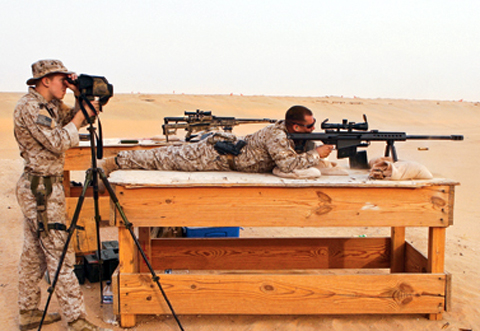
Barrett’s M107 operating system allows the rifle to function reliably in the harshest environments. U.S. Marine Corps Sgt. Daniel Price, left, a team leader with 3rd Platoon, Alpha Company, 1st Marine Reconnaissance Battalion, 13th Marine Expeditionary Unit, spots impacts down range for Gunnery Sgt. David Lind, a platoon sergeant with 3rd Platoon, Alpha Company, 1st Marine Reconnaissance Battalion, 13th Marine Expeditionary Unit, while he zeros his .50-caliber M107 special applications scoped rifle from an unknown distance on Udari range, Kuwait. (U.S. Marine Corps photo by Lance Cpl. Kyle J. Keathley) (Released)
Bushmaster BA50
Bushmaster entered into the .50 BMG realm a few years ago by offering the BA50. Just like every precision bolt-action .50 BMG rifle on the market, the BA50 is built to tolerances and specifications that allow sub-MOA capabilities. Its overall length is 58 inches, and the rifle weighs in at 33 pounds with a 30-inch Lothar Walther barrel and 10-round magazine. The muzzle velocity averages 2,945 FPS with standard military M33 ball ammunition with 661-grain projectiles, and the rifle comes with a full-length Picatinny rail that runs the entire length of the forearm to accommodate night optics. Assembly of the BA50 is one of the simplest on the market for dedicated bolt-action .50 BMG rifles. Similar to the AR design, the upper receiver locks on to the lower receiver with two pins integral to the lower receiver.
The BA50 is hammer-fired, similar to the AR design, easing maintenance and aiding in reliability. Accuracy relies heavily on locking consistency and support of the cartridge and projectile. Tighter tolerances in the chamber area allow for a more consistent expansion of the cartridge as the powders ignite. The BA50 allows for a higher accuracy standard with a more modular chassis.
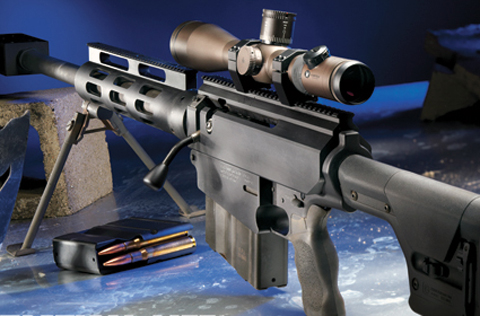
With high-quality glass mounted on Bushmaster’s .50-caliber beast, it’s a machine ready for anti-materiel and EOD disposal missions.
Barrett’s .50 BMG
Currently, the only mainstream, widely used semi-automatic, shoulder-fired .50 BMG rifle is the Barrett M82A1/M107. The weapon system functions via a short recoil operating system, similar to the Browning M2 machine gun chambered in the same cartridge. This creates an excessive amount of movement in the rifle, lowering the accuracy expectations to 2.5 MOA (or larger depending on how the firing position is set up). But it does utilize a 10-round magazine, allowing for a higher rate of fire, and has been proven to be extremely reliable in rugged environments. Military units around the world run this rifle platform and it has been extremely effective on the battlefields of Afghanistan and Iraq.

Designed for sub-MOA accuracy and with tight tolerances, the bolt-action Bushmaster BA50 is a very capable sniper rifle.
BLOG ARCHIVES

Air Force snipers help TW find the big bore that packs all the right punch!

Barrett’s M107 operating system allows the rifle to function reliably in the harshest environments. U.S. Marine Corps Sgt. Daniel Price, left, a team leader with 3rd Platoon, Alpha Company, 1st Marine Reconnaissance Battalion, 13th Marine Expeditionary Unit, spots impacts down range for Gunnery Sgt. David Lind, a platoon sergeant with 3rd Platoon, Alpha Company, 1st Marine Reconnaissance Battalion, 13th Marine Expeditionary Unit, while he zeros his .50-caliber M107 special applications scoped rifle from an unknown distance on Udari range, Kuwait. (U.S. Marine Corps photo by Lance Cpl. Kyle J. Keathley) (Released)
Bushmaster BA50
Bushmaster entered into the .50 BMG realm a few years ago by offering the BA50. Just like every precision bolt-action .50 BMG rifle on the market, the BA50 is built to tolerances and specifications that allow sub-MOA capabilities. Its overall length is 58 inches, and the rifle weighs in at 33 pounds with a 30-inch Lothar Walther barrel and 10-round magazine. The muzzle velocity averages 2,945 FPS with standard military M33 ball ammunition with 661-grain projectiles, and the rifle comes with a full-length Picatinny rail that runs the entire length of the forearm to accommodate night optics. Assembly of the BA50 is one of the simplest on the market for dedicated bolt-action .50 BMG rifles. Similar to the AR design, the upper receiver locks on to the lower receiver with two pins integral to the lower receiver.
The BA50 is hammer-fired, similar to the AR design, easing maintenance and aiding in reliability. Accuracy relies heavily on locking consistency and support of the cartridge and projectile. Tighter tolerances in the chamber area allow for a more consistent expansion of the cartridge as the powders ignite. The BA50 allows for a higher accuracy standard with a more modular chassis.

With high-quality glass mounted on Bushmaster’s .50-caliber beast, it’s a machine ready for anti-materiel and EOD disposal missions.
Barrett’s .50 BMG
Currently, the only mainstream, widely used semi-automatic, shoulder-fired .50 BMG rifle is the Barrett M82A1/M107. The weapon system functions via a short recoil operating system, similar to the Browning M2 machine gun chambered in the same cartridge. This creates an excessive amount of movement in the rifle, lowering the accuracy expectations to 2.5 MOA (or larger depending on how the firing position is set up). But it does utilize a 10-round magazine, allowing for a higher rate of fire, and has been proven to be extremely reliable in rugged environments. Military units around the world run this rifle platform and it has been extremely effective on the battlefields of Afghanistan and Iraq.

Designed for sub-MOA accuracy and with tight tolerances, the bolt-action Bushmaster BA50 is a very capable sniper rifle.
BLOG ARCHIVES

Posted by echigoyaworks
at 19:00
2012年07月22日
Dynamic Warriors
私たちのブログを訪問していただきありがとうございます。あなたがお持ちの場合DIYの要求は私達に電子メールを送信してください。
Run the gun and your mind through Magpul’s high-speed, low-drag carbine course with today’s top tactical operators!
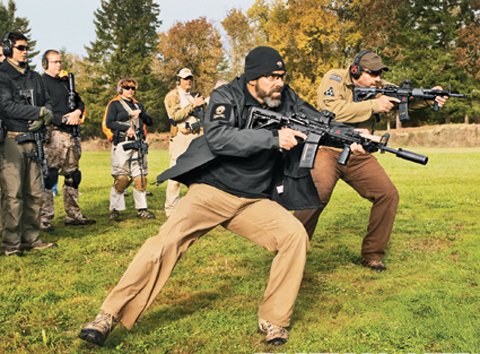
Little of the Magpul Dynamics course is standing on the flat range firing numbered shot counts. Students are taught to move, turn, problem solve and deliver accurate shots.
To check out the company that has sold more than 1.5 million polymer magazines and whose training division raised the bar on instructional videos with its Art of the Dynamic Carbine (1&2), Art of Dynamic Handgun and Aerial Platform Operations Series, TW stepped inside the Magpul Dynamics’ Dynamic Carbine Course in Hammond, LA to see if these guys are as good as their videos.
Dynamic Carbine 1: Building the Fundamentals
"We will give the students an honest snapshot of themselves, very quickly,” says Chris Costa, Magpul Dynamics Instructor. The Dynamic Carbine 1 course brought together shooters from across the country and throughout the range of shooting experience. There were several husband and wife attendees, a father and son, as well as law enforcement, hobbyists, and professional security contractors. After a detailed safety briefing, instructors Costa, Haley, and Olivella began building up the fundamentals in their students. Starting with basic body position, stance, and trigger control, the class moved to confirming zero on their optics. Once zeroed, in-depth work began on sight picture/sight alignment differences at ranges from 5 to 50 yards. Reload techniques such as speed (under fire), tactical (in action, but covered), and admin (no threat, get re-organized) were covered, as well as malfunction drills (double-feed, mag failure, mis-fire, stovepipe).
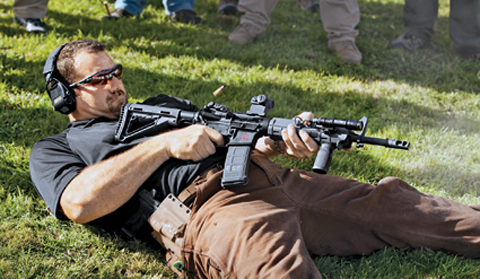
Instructor demonstrates the supine position. The position is a critical skill that allows shooter to tactically recover from a slip or dramatically reduce his profile while continuing to deliver well-aimed shots under fire.
As the course continued over the next three days, BSA drills (“Balance of Speed and Accuracy”) became a common element. The BSA drill measures timed rounds into an 8-inch center-mass circle on the man-sized Magpul targets. Students were encouraged to push their limits from standing, kneeling, and prone positions at varying distances. The targets told the tale: If the group was too tight with no hits outside the circle, speed was lacking. If the group was scattered outside the circle, the shooter should slow down and concentrate on body position and accuracy. This litmus test gave each student instant feedback at every drill as to how fast he/she could push the rifle and put combat-effective hits on the target.
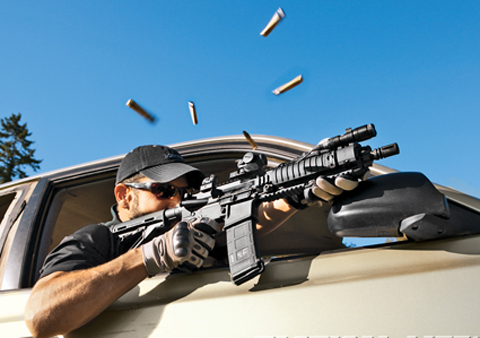
Magpul tests both decision making and weapons handling skills. Above, a student engages multiple targets from the open window of a vehicle.
On the afternoon of day two, the instructors conducted a “mini” handgun course. While the handgun is typically a class unto itself, the transition to the handgun in the event of a carbine malfunction at close range is a crucial skill and would become a part of many of our subsequent drills. Day three brought a significant increase in the pace of the drills, which now included weapons transitions, timed speed events, movement to multiple targets and barricade obstacle shooting. Dynamic Carbine 1 ended with shooters more confident, competent, and mindful than when they arrived.
BLOG ARCHIVES

Run the gun and your mind through Magpul’s high-speed, low-drag carbine course with today’s top tactical operators!

Little of the Magpul Dynamics course is standing on the flat range firing numbered shot counts. Students are taught to move, turn, problem solve and deliver accurate shots.
To check out the company that has sold more than 1.5 million polymer magazines and whose training division raised the bar on instructional videos with its Art of the Dynamic Carbine (1&2), Art of Dynamic Handgun and Aerial Platform Operations Series, TW stepped inside the Magpul Dynamics’ Dynamic Carbine Course in Hammond, LA to see if these guys are as good as their videos.
Dynamic Carbine 1: Building the Fundamentals
"We will give the students an honest snapshot of themselves, very quickly,” says Chris Costa, Magpul Dynamics Instructor. The Dynamic Carbine 1 course brought together shooters from across the country and throughout the range of shooting experience. There were several husband and wife attendees, a father and son, as well as law enforcement, hobbyists, and professional security contractors. After a detailed safety briefing, instructors Costa, Haley, and Olivella began building up the fundamentals in their students. Starting with basic body position, stance, and trigger control, the class moved to confirming zero on their optics. Once zeroed, in-depth work began on sight picture/sight alignment differences at ranges from 5 to 50 yards. Reload techniques such as speed (under fire), tactical (in action, but covered), and admin (no threat, get re-organized) were covered, as well as malfunction drills (double-feed, mag failure, mis-fire, stovepipe).

Instructor demonstrates the supine position. The position is a critical skill that allows shooter to tactically recover from a slip or dramatically reduce his profile while continuing to deliver well-aimed shots under fire.
As the course continued over the next three days, BSA drills (“Balance of Speed and Accuracy”) became a common element. The BSA drill measures timed rounds into an 8-inch center-mass circle on the man-sized Magpul targets. Students were encouraged to push their limits from standing, kneeling, and prone positions at varying distances. The targets told the tale: If the group was too tight with no hits outside the circle, speed was lacking. If the group was scattered outside the circle, the shooter should slow down and concentrate on body position and accuracy. This litmus test gave each student instant feedback at every drill as to how fast he/she could push the rifle and put combat-effective hits on the target.

Magpul tests both decision making and weapons handling skills. Above, a student engages multiple targets from the open window of a vehicle.
On the afternoon of day two, the instructors conducted a “mini” handgun course. While the handgun is typically a class unto itself, the transition to the handgun in the event of a carbine malfunction at close range is a crucial skill and would become a part of many of our subsequent drills. Day three brought a significant increase in the pace of the drills, which now included weapons transitions, timed speed events, movement to multiple targets and barricade obstacle shooting. Dynamic Carbine 1 ended with shooters more confident, competent, and mindful than when they arrived.
BLOG ARCHIVES

Posted by echigoyaworks
at 12:00
2012年07月21日
Smith & Wesson Bodyguards
私たちのブログを訪問していただきありがとうございます。あなたがお持ちの場合DIYの要求は私達に電子メールを送信してください。
Laser-equipped deep-cover .38 snubbie and .380 auto — ideal for back-up carry!
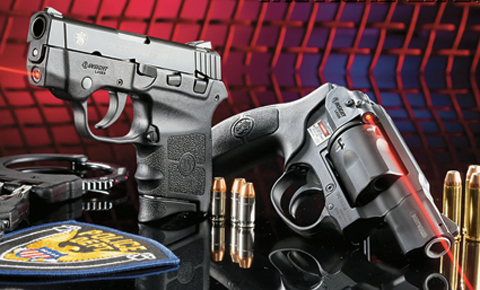
WHEN IT COMES TO HAVING A CORNER ON THE DEEP-COVER carry market, nobody beats out Smith & Wesson. Beginning with the “Chief’s Special,” an ultra-compact snubnose packing five rounds of .38 Special into the tiny J-frame package, the company created the basis for what would become the iconic deep-concealment revolver and back-up gun for law enforcement officers around the country.
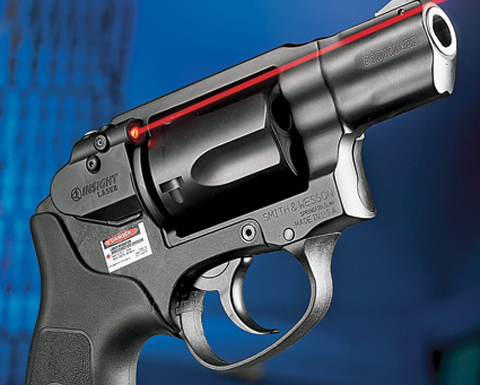
An integrated Insight red laser sight assembly is located to the right rear of the cylinder on the Bodyguard 38.
With lightweight variants, differently chambered versions, and ones with longer barrels or different grips or different sights, it seemed that just about every variation of the design was developed for every conceivable contingency. However, at its core, the classic J-frame was a design from a different era, being first offered in the 1950s, and one that was both time-consuming and relatively expensive to manufacture.
Although sales were (and still are) extremely strong on the traditional J-frames, Smith & Wesson recognized that there was a need for the development of a radically modern deep-concealment revolver—one that took advantage of the most modern of materials and construction methods and that hit a lower retail price point.
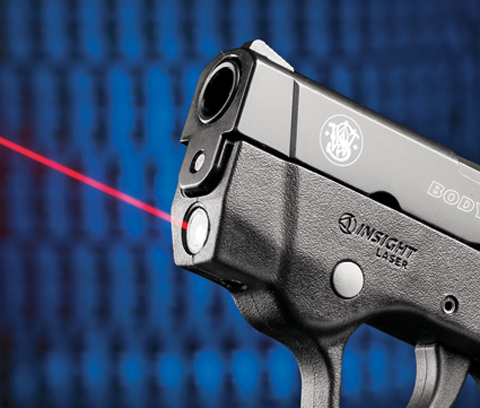
The Insight laser module of the 380 is internally located within the dustcover portion of the polymer frame. Note the light gray round activation button.
Concurrent with this realization was an acknowledgement on Smith & Wesson’s part of the extreme demand in the market for deep-concealment semi-autos chambered in .380 ACP that offered good power in a very small package. In response, the company began the process of developing what we now know today as the “Bodyguards”—a .38 Special revolver and .380 ACP sub-compact autopistol.
Laser-equipped deep-cover .38 snubbie and .380 auto — ideal for back-up carry!

WHEN IT COMES TO HAVING A CORNER ON THE DEEP-COVER carry market, nobody beats out Smith & Wesson. Beginning with the “Chief’s Special,” an ultra-compact snubnose packing five rounds of .38 Special into the tiny J-frame package, the company created the basis for what would become the iconic deep-concealment revolver and back-up gun for law enforcement officers around the country.

An integrated Insight red laser sight assembly is located to the right rear of the cylinder on the Bodyguard 38.
With lightweight variants, differently chambered versions, and ones with longer barrels or different grips or different sights, it seemed that just about every variation of the design was developed for every conceivable contingency. However, at its core, the classic J-frame was a design from a different era, being first offered in the 1950s, and one that was both time-consuming and relatively expensive to manufacture.
Although sales were (and still are) extremely strong on the traditional J-frames, Smith & Wesson recognized that there was a need for the development of a radically modern deep-concealment revolver—one that took advantage of the most modern of materials and construction methods and that hit a lower retail price point.

The Insight laser module of the 380 is internally located within the dustcover portion of the polymer frame. Note the light gray round activation button.
Concurrent with this realization was an acknowledgement on Smith & Wesson’s part of the extreme demand in the market for deep-concealment semi-autos chambered in .380 ACP that offered good power in a very small package. In response, the company began the process of developing what we now know today as the “Bodyguards”—a .38 Special revolver and .380 ACP sub-compact autopistol.
Posted by echigoyaworks
at 19:00
2012年07月21日
Arctic S.W.A.T
私たちのブログを訪問していただきありがとうございます。あなたがお持ちの場合DIYの要求は私達に電子メールを送信してください。
Last frontier lawmen protect 2,000 square miles of extreme country with cutting-edge weapons and tactics!
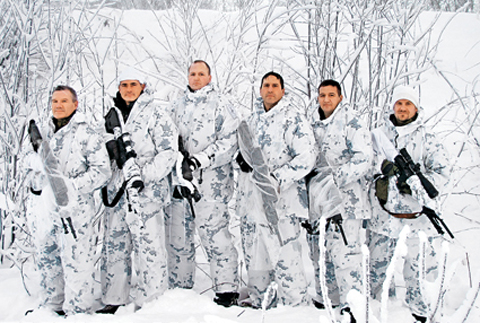
Members of the APD S.W.A.T. sniper team blend into their arctic surroundings with MARPAT overwhites. Knight’s Armament SR-25 MK 11 rifles are their main guns.
“APD, Channel One units, respond to an 11-5 in progress at 4501 Elmore Road. Complainant advises there is a bear charging their sliding glass door.”
That’s not an everyday call, but it’s not uncommon, either, when you’re a police officer in Anchorage, Alaska. I first saw Anchorage in March of 1978. I was a few years out of the Army and was trying to get hired as an Alaska State Trooper. I was blown away that the ice on the parking lot was still 2 inches thick, there was 2 feet of snow on the ground, and that it was 16 degrees. It was offset by the fact that I was in Alaska.
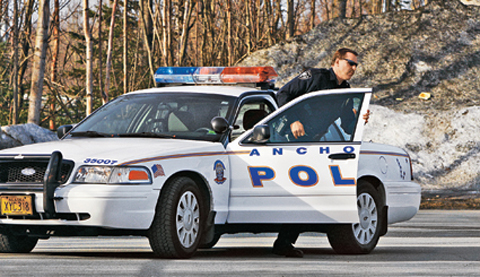
Anchorage officers are cross-trained to handle many duties. Strong community relations are a key tactic in helping to keep the peace.
Anchorage is policed by the Anchorage Police Department (APD). The Municipality of Anchorage is the largest in Alaska. The population of nearly 300,000 souls is almost half the population of the state, but 90 percent of the state’s residents use Anchorage as their transportation, shopping and recreation hub. Lots of rural residents come to town to see the lights, party a little too hard and need police services. Police calls are made more difficult when the temperature is -30, with a 10 mph wind blowing off the inlet. Summers are fairly short and intense; with 24 hours of daylight, Alaskans tend to ignore sleep, knowing they can catch up in December. It can result in long, hard workdays for the APD.
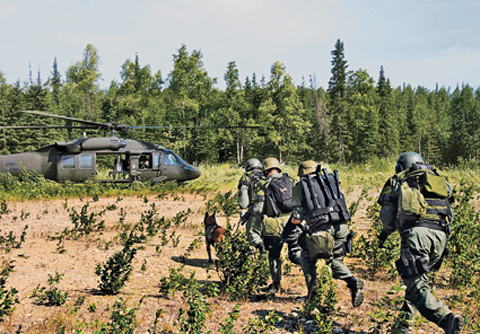
Anchorage S.W.A.T. practices mobile air operations with a Black Hawk helicopter, which they use to deploy to remote areas faster.
Since Anchorage is a “distance-isolated city in a distance-isolated state,” the APD relies on excellent police-community relations to accomplish the mission. There is constant demand for demonstrations from schools, youth groups and job fairs, and vehicles and K-9s are special hits with school kids. In order to maintain close public ties, the APD uses outreach teams, school resource officers and a citizen police academy to improve communication and cooperation; a volunteer Search Team helps find lost folks and search for evidence. The APD is also moving toward assigning officers to the same areas in an effort to form stronger community ties.
BLOG ARCHIVES

Last frontier lawmen protect 2,000 square miles of extreme country with cutting-edge weapons and tactics!

Members of the APD S.W.A.T. sniper team blend into their arctic surroundings with MARPAT overwhites. Knight’s Armament SR-25 MK 11 rifles are their main guns.
“APD, Channel One units, respond to an 11-5 in progress at 4501 Elmore Road. Complainant advises there is a bear charging their sliding glass door.”
That’s not an everyday call, but it’s not uncommon, either, when you’re a police officer in Anchorage, Alaska. I first saw Anchorage in March of 1978. I was a few years out of the Army and was trying to get hired as an Alaska State Trooper. I was blown away that the ice on the parking lot was still 2 inches thick, there was 2 feet of snow on the ground, and that it was 16 degrees. It was offset by the fact that I was in Alaska.

Anchorage officers are cross-trained to handle many duties. Strong community relations are a key tactic in helping to keep the peace.
Anchorage is policed by the Anchorage Police Department (APD). The Municipality of Anchorage is the largest in Alaska. The population of nearly 300,000 souls is almost half the population of the state, but 90 percent of the state’s residents use Anchorage as their transportation, shopping and recreation hub. Lots of rural residents come to town to see the lights, party a little too hard and need police services. Police calls are made more difficult when the temperature is -30, with a 10 mph wind blowing off the inlet. Summers are fairly short and intense; with 24 hours of daylight, Alaskans tend to ignore sleep, knowing they can catch up in December. It can result in long, hard workdays for the APD.

Anchorage S.W.A.T. practices mobile air operations with a Black Hawk helicopter, which they use to deploy to remote areas faster.
Since Anchorage is a “distance-isolated city in a distance-isolated state,” the APD relies on excellent police-community relations to accomplish the mission. There is constant demand for demonstrations from schools, youth groups and job fairs, and vehicles and K-9s are special hits with school kids. In order to maintain close public ties, the APD uses outreach teams, school resource officers and a citizen police academy to improve communication and cooperation; a volunteer Search Team helps find lost folks and search for evidence. The APD is also moving toward assigning officers to the same areas in an effort to form stronger community ties.
BLOG ARCHIVES

Posted by echigoyaworks
at 12:00
2012年07月20日
Locked, Loaded & Ready
私たちのブログを訪問していただきありがとうございます。あなたがお持ちの場合DIYの要求は私達に電子メールを送信してください。
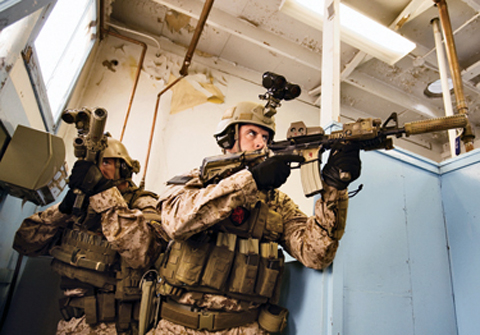
Like the U.S. Navy SEALs who are trained and have been deployed in a wide variety of missions, including direct action and special recon, unconventional warfare, counter-terrorism, and other missions, TW has your back!
French statesman Duc de Richelieu (1766-1822) was once reviewing a proposed military campaign. When an officer placed a finger on a map with the remark, “We shall cross the river at this point,” Richelieu replied, “Excellent, sir, but your finger is not a bridge.”
Grand plans and big talk are one thing; For the grand plan to survive the first contact with an enemy depends on the total readiness of the forces involved. Give the Duke credit: Even in that distant time, he knew his forces would have to be mission ready—with weapons, tactics and combat psyche.
Today’s military and LE operators routinely must meet mission readiness requirements, of which no soldier from Richelieu’s time could have dreamed. How today’s professionals are doing exactly that is the theme of this special “Mission Ready” edition of TW.
Individual firepower is always an important subject in TW, and this issue covers the topic particularly well. For openers, consider our testfire report on the new Remington Semi-Automatic Sniper System made in partnership with JPE and AAC. Another sniper testfire covers the Steyr SSG08 now available in .338 Lapua Magnum.
BLOG ARCHIVES


Like the U.S. Navy SEALs who are trained and have been deployed in a wide variety of missions, including direct action and special recon, unconventional warfare, counter-terrorism, and other missions, TW has your back!
French statesman Duc de Richelieu (1766-1822) was once reviewing a proposed military campaign. When an officer placed a finger on a map with the remark, “We shall cross the river at this point,” Richelieu replied, “Excellent, sir, but your finger is not a bridge.”
Grand plans and big talk are one thing; For the grand plan to survive the first contact with an enemy depends on the total readiness of the forces involved. Give the Duke credit: Even in that distant time, he knew his forces would have to be mission ready—with weapons, tactics and combat psyche.
Today’s military and LE operators routinely must meet mission readiness requirements, of which no soldier from Richelieu’s time could have dreamed. How today’s professionals are doing exactly that is the theme of this special “Mission Ready” edition of TW.
Individual firepower is always an important subject in TW, and this issue covers the topic particularly well. For openers, consider our testfire report on the new Remington Semi-Automatic Sniper System made in partnership with JPE and AAC. Another sniper testfire covers the Steyr SSG08 now available in .338 Lapua Magnum.
BLOG ARCHIVES

Posted by echigoyaworks
at 21:00
2012年07月20日
McMillan Tac .308
私たちのブログを訪問していただきありがとうございます。あなたがお持ちの場合DIYの要求は私達に電子メールを送信してください。
Designed for the professional marksman to perform in the harshest of conditions!

When one thinks of precision tactical rifles, one of the first names that come to mind is McMillan. McMillan has established a well-deserved reputation for manufacturing some of the highest quality and most accurate rifles on the planet.
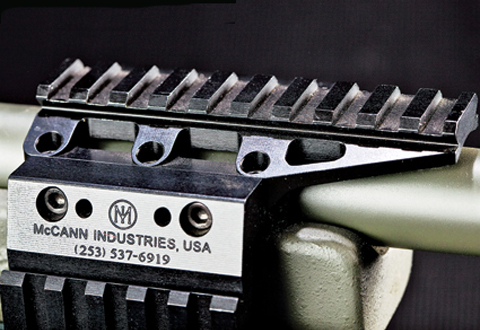
The TAC-308 came equipped with a McCann Industries forward rail system to offer even more “real estate” for accessories.
McMillan manufactures a complete line of rifles for sport shooters, competitive shooters and military or law enforcement marksmen. If a standard McMillan rifle doesn’t meet customer requirements, the company will build a rifle that does. All rifles include a McMillan custom pillar-bedded fiberglass stock, a match-grade stainless steel barrel and Remington type trigger, and are finished in DuraCoat, a durable wear-resistant polymer.
The McMillan TAC-308 Tactical Rifle uses their “top of the line” G30 action, built by the company to aerospace standards, with each action CNC-machined from a solid billet. The action material is 17-4 stainless steel, which is tougher and more corrosion resistant than the 4000-series alloy often encountered in firearms. The steel is hardened to 42-43 Rockwell C. The action face is absolutely perpendicular to the bolt axis. General tolerances are held to 0.005 of an inch, while critical components are machined to 0.0005 of an inch. The chamber and barrel threads are cut to critical tolerances and then hand-fitted.
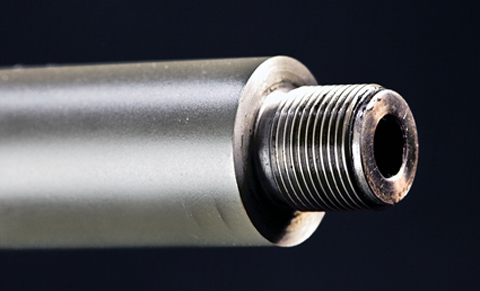
All McMillan barrels are premium, hand-lapped, match-grade stainless steel, capable of delivering exceptional performance. A removable cap protects the rifle’s threaded muzzle (shown) that can accept a variety of suppressors or muzzle brakes.
BLOG ARCHIVES

Designed for the professional marksman to perform in the harshest of conditions!

When one thinks of precision tactical rifles, one of the first names that come to mind is McMillan. McMillan has established a well-deserved reputation for manufacturing some of the highest quality and most accurate rifles on the planet.

The TAC-308 came equipped with a McCann Industries forward rail system to offer even more “real estate” for accessories.
McMillan manufactures a complete line of rifles for sport shooters, competitive shooters and military or law enforcement marksmen. If a standard McMillan rifle doesn’t meet customer requirements, the company will build a rifle that does. All rifles include a McMillan custom pillar-bedded fiberglass stock, a match-grade stainless steel barrel and Remington type trigger, and are finished in DuraCoat, a durable wear-resistant polymer.
The McMillan TAC-308 Tactical Rifle uses their “top of the line” G30 action, built by the company to aerospace standards, with each action CNC-machined from a solid billet. The action material is 17-4 stainless steel, which is tougher and more corrosion resistant than the 4000-series alloy often encountered in firearms. The steel is hardened to 42-43 Rockwell C. The action face is absolutely perpendicular to the bolt axis. General tolerances are held to 0.005 of an inch, while critical components are machined to 0.0005 of an inch. The chamber and barrel threads are cut to critical tolerances and then hand-fitted.

All McMillan barrels are premium, hand-lapped, match-grade stainless steel, capable of delivering exceptional performance. A removable cap protects the rifle’s threaded muzzle (shown) that can accept a variety of suppressors or muzzle brakes.
BLOG ARCHIVES

Posted by echigoyaworks
at 16:00
2012年07月20日
U.S. Ordnance MK43
私たちのブログを訪問していただきありがとうございます。あなたがお持ちの場合DIYの要求は私達に電子メールを送信してください。
Next-gen M60 general-purpose machine gun—lighter and faster

The U.S. Ordnance MK43 represents 22 key improvements on the M60 base model, cutting redundant parts and creating a lighter, more accurate machine gun that can produce a superior volume of fire downrange.
When most think of a machine gun, they picture a weapon supported by a bipod or fixed mount being fired by one man as others pass ammunition. The U.S. Ordnance MK43 Mod 1, a 7.62×51mm General Purpose Machine Gun (GPMG), changes this view by giving soldiers a fully automatic belt-fed weapon designed specifically to be shouldered and fired from off-hand, kneeling and prone positions by a lone shooter. The MK43 represents the latest improvement to the M60 series of machine guns to which it belongs.
First introduced in 1957, the M60 has seen service with every branch of the U.S. military, and remains in their arsenals over 50 years later. Since the late-1970s, however, its dominance has steadily declined as the M240 was phased in as a more reliable and easier to maintain weapon despite its higher cost and solider complaints about its heavier weight. U.S. Ordnance is looking to change this trend with the MK43, which maintains the familiar design of the M60 while addressing the negative issues of preceding models. A modified M60E4, all of the MK43’s major components are directly interchangeable with other M60 configurations, and older weapons can be converted to the updated design by an armorer within 30 minutes without any requirement for complex tools or machines.

M60 Reborn
Available in both ground and mounted configurations, the MK43 is a gas-operated, disintegrating link, belt-fed and air-cooled medium machine gun that fires from an open bolt. Weighing only 20.61 pounds with its long barrel, the weapon is lighter than its predecessors and its M240B competition, and has an associated smaller length, ranging between 37.7 inches to 42.4 inches overall depending on barrel selection. The weapon’s cyclic rate of fire is 500 rounds per minute with a muzzle velocity of 2,800 FPS. Its maximum range is 4,075 yards and its effective range is 1,200 yards.
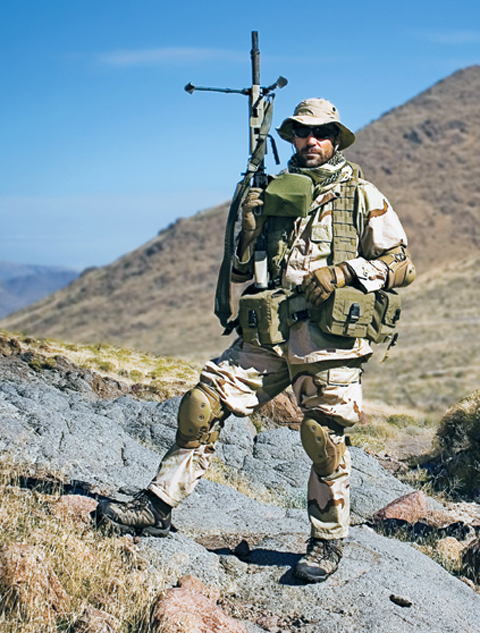
Light and compact, the MK43 provides increased mobility and uniquely allows for accurate, controllable off-hand shooting.
BLOG ARCHIVES

Next-gen M60 general-purpose machine gun—lighter and faster

The U.S. Ordnance MK43 represents 22 key improvements on the M60 base model, cutting redundant parts and creating a lighter, more accurate machine gun that can produce a superior volume of fire downrange.
When most think of a machine gun, they picture a weapon supported by a bipod or fixed mount being fired by one man as others pass ammunition. The U.S. Ordnance MK43 Mod 1, a 7.62×51mm General Purpose Machine Gun (GPMG), changes this view by giving soldiers a fully automatic belt-fed weapon designed specifically to be shouldered and fired from off-hand, kneeling and prone positions by a lone shooter. The MK43 represents the latest improvement to the M60 series of machine guns to which it belongs.
First introduced in 1957, the M60 has seen service with every branch of the U.S. military, and remains in their arsenals over 50 years later. Since the late-1970s, however, its dominance has steadily declined as the M240 was phased in as a more reliable and easier to maintain weapon despite its higher cost and solider complaints about its heavier weight. U.S. Ordnance is looking to change this trend with the MK43, which maintains the familiar design of the M60 while addressing the negative issues of preceding models. A modified M60E4, all of the MK43’s major components are directly interchangeable with other M60 configurations, and older weapons can be converted to the updated design by an armorer within 30 minutes without any requirement for complex tools or machines.

M60 Reborn
Available in both ground and mounted configurations, the MK43 is a gas-operated, disintegrating link, belt-fed and air-cooled medium machine gun that fires from an open bolt. Weighing only 20.61 pounds with its long barrel, the weapon is lighter than its predecessors and its M240B competition, and has an associated smaller length, ranging between 37.7 inches to 42.4 inches overall depending on barrel selection. The weapon’s cyclic rate of fire is 500 rounds per minute with a muzzle velocity of 2,800 FPS. Its maximum range is 4,075 yards and its effective range is 1,200 yards.

Light and compact, the MK43 provides increased mobility and uniquely allows for accurate, controllable off-hand shooting.
BLOG ARCHIVES

Posted by echigoyaworks
at 10:00
2012年07月19日
Savage M10 FLCP-K .308
私たちのブログを訪問していただきありがとうございます。あなたがお持ちの場合DIYの要求は私達に電子メールを送信してください。
Highly specialized precision rifle with custom-style enhancements and accuracy!

Savage’s Model 10 FLCP-K in .308 is a left-hand precision rifle that offers LE users a sub-MOA rifle for less than $1,000. Shown equipped with a Leupold Mark 4 4.5-14×50mm ER/T scope and Versa-Pod bipod.
A first thought, the precision rifle market would seem to be a prime example of this reality, with high-end custom models built off of production rifles boasting sub-MOA accuracy can run easily into the thousands of dollars. So, to be able to reliably put lead on target in sub-MOA groups time after time, the bottom line is that you must purchase a multi-thousand dollar rifle that has been custom-tuned within an inch of its life, right? Wrong.

The left-handed action of the Model 10 FLCP-K features an oversized target-style bolt handle and is drilled and tapped.
Enter Savage Arms and its Law Enforcement Series of rifles. And a prime example of the specialized capabilities of these rifles is the Model 10 FLCP-K, a left-handed .308 bolt-action rifle with a suggested retail price of a mere $893. This platform, also available in .223, offers law enforcement officers a highly specialized precision rifle that won’t break even the most strained of today’s budgets.
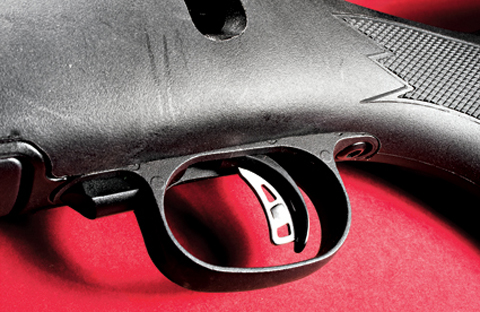
The AccuTrigger is designed to be safe from accidental discharges through a sear-blocking trigger safety located in the center of the trigger.
The backbone of Savage Arms’ rifle line is actually a simple, arguably unattractive (although I find utilitarian to be beautiful) bolt-action rifle that the company has been producing in one form or another for about five decades. That rifle was the Model 110, designed by a former employee named Nicholas Brewer and one with a very novel approach to manufacturing. Specifically, it prized modular adaptability and ease of production over more subjective aesthetic concerns.
BLOG ARCHIVES

Highly specialized precision rifle with custom-style enhancements and accuracy!

Savage’s Model 10 FLCP-K in .308 is a left-hand precision rifle that offers LE users a sub-MOA rifle for less than $1,000. Shown equipped with a Leupold Mark 4 4.5-14×50mm ER/T scope and Versa-Pod bipod.
A first thought, the precision rifle market would seem to be a prime example of this reality, with high-end custom models built off of production rifles boasting sub-MOA accuracy can run easily into the thousands of dollars. So, to be able to reliably put lead on target in sub-MOA groups time after time, the bottom line is that you must purchase a multi-thousand dollar rifle that has been custom-tuned within an inch of its life, right? Wrong.

The left-handed action of the Model 10 FLCP-K features an oversized target-style bolt handle and is drilled and tapped.
Enter Savage Arms and its Law Enforcement Series of rifles. And a prime example of the specialized capabilities of these rifles is the Model 10 FLCP-K, a left-handed .308 bolt-action rifle with a suggested retail price of a mere $893. This platform, also available in .223, offers law enforcement officers a highly specialized precision rifle that won’t break even the most strained of today’s budgets.

The AccuTrigger is designed to be safe from accidental discharges through a sear-blocking trigger safety located in the center of the trigger.
The backbone of Savage Arms’ rifle line is actually a simple, arguably unattractive (although I find utilitarian to be beautiful) bolt-action rifle that the company has been producing in one form or another for about five decades. That rifle was the Model 110, designed by a former employee named Nicholas Brewer and one with a very novel approach to manufacturing. Specifically, it prized modular adaptability and ease of production over more subjective aesthetic concerns.
BLOG ARCHIVES

Posted by echigoyaworks
at 21:00
2012年07月19日
FNH FNP-45 .45ACP
私たちのブログを訪問していただきありがとうございます。あなたがお持ちの場合DIYの要求は私達に電子メールを送信してください。
Rugged, reliable, accurate—it’s READY FOR DUTY!

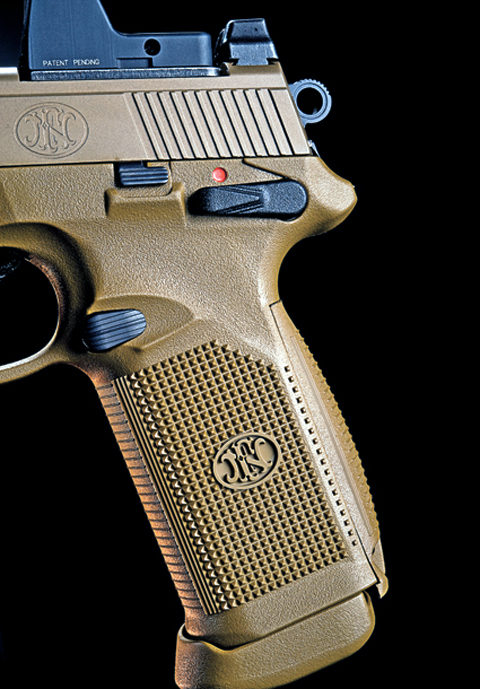
When you’re in the field, simple is what you want in a sidearm. Sometimes you just have to react and pull the trigger — it’s that simple. For the better part of the 20th century, “simple” in terms of military sidearms was defined by the numerals 1-9-1-1. Over the last 100 years two schools of thought have emerged, actually two differences of opinion, one that favors the Colt Model 1911/1911A1 and its derivatives as an ideal large caliber sidearm, and one that doesn’t.
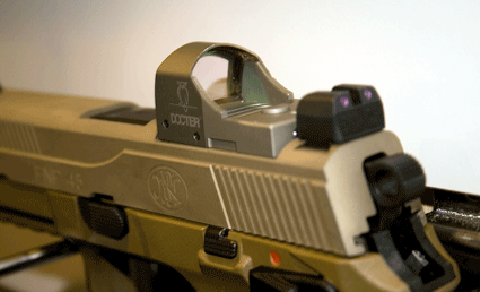
FNH USA’s FNP-45 Tactical is the perfect .45 ACP pistol for those who subscribe to the belief that a single-action semi-auto carried cocked and locked is not ideal. The line of demarcation is simply a choice. In 1985, our government made that choice and switched from the venerable Colt Model 1911A1 to the DA/SA Beretta M9 9mm. The .45 ACP was no longer the caliber of choice for a military sidearm. The choice that Fabrique Nationale brings to the table with the FNP-45 Tactical is that most favorite of options: a .45 ACP, DA/SA semi-automatic that can be safely decocked and carried with a chambered round. There are many handguns that offer this feature — some nearly as old as the Model 1911. Few, however, do it quite as well as the new FNP-45 Tactical.
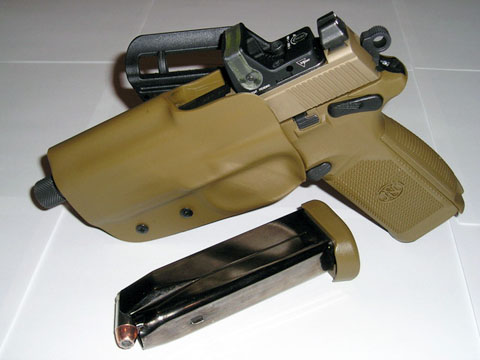
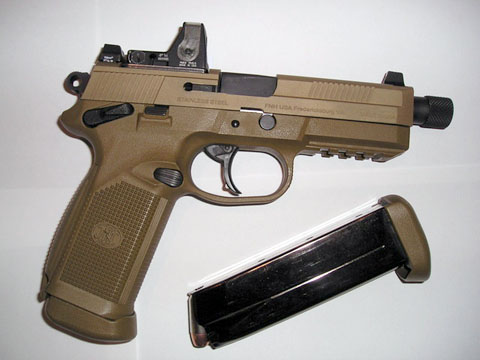
BLOG ARCHIVES

Rugged, reliable, accurate—it’s READY FOR DUTY!


When you’re in the field, simple is what you want in a sidearm. Sometimes you just have to react and pull the trigger — it’s that simple. For the better part of the 20th century, “simple” in terms of military sidearms was defined by the numerals 1-9-1-1. Over the last 100 years two schools of thought have emerged, actually two differences of opinion, one that favors the Colt Model 1911/1911A1 and its derivatives as an ideal large caliber sidearm, and one that doesn’t.

FNH USA’s FNP-45 Tactical is the perfect .45 ACP pistol for those who subscribe to the belief that a single-action semi-auto carried cocked and locked is not ideal. The line of demarcation is simply a choice. In 1985, our government made that choice and switched from the venerable Colt Model 1911A1 to the DA/SA Beretta M9 9mm. The .45 ACP was no longer the caliber of choice for a military sidearm. The choice that Fabrique Nationale brings to the table with the FNP-45 Tactical is that most favorite of options: a .45 ACP, DA/SA semi-automatic that can be safely decocked and carried with a chambered round. There are many handguns that offer this feature — some nearly as old as the Model 1911. Few, however, do it quite as well as the new FNP-45 Tactical.


BLOG ARCHIVES

Posted by echigoyaworks
at 16:00


